#they are so cleverly adapted to make sense to a different audience
Text
GUYS
I don’t think I’ve ever mentioned this before actually but i am spanish 🤩🥳🤪
and I just found out that. not only was there a spanish production of spamalot back in 2009. but also. THERE IS A WHOLE ASS CAST RECORDING UP ON SPOTIFY. AND IT’S SO GOOD
I’ve also found a couple clips on youtube and omg it’s better than I could’ve ever imagined
#tbh when I first found out I was skeptical because I didn’t think there was a demand for monty python in spain#since it isn’t nearly as popular here as it is in English speaking countries#but omg#honestly if I didn’t know anything about it prior and you told me it was made by Spanish people I would believe you no hesitation#it works so well#I was also worried about referenced and jokes getting lost in translation but NO#they are so cleverly adapted to make sense to a different audience#and WOW#spamalot#mars rants
0 notes
Text
Film Adaptations and Their Devotion to Source Material
Call me crazy, but I genuinely prefer when movie adaptations have nothing to do with the book. I don't mean when a movie mucks up the source material like 1984 'Dune.' I'm talking gutting it and making something new from its concepts, like 'Bladerunner.' It's a phenomenal movie but has nothing to do with the book(which is also phenomenal.) Both works have the same foundation: A hired killer named Deckard hunts down a group of escaped androids through future California. But they both take it in very different directions that better complement the medium through which the story is told. Personally, I prefer 'Do Androids Dream of Electric Sheep' over 'Blade Runner' (cuz I like reading,) but If some hack tried to make a new adaptation, I'd strangle them to death with my own hands. It would be ass, downright atrocious. It just wouldn't work. It's harder to confuse an audience visually in the way the book does. I just don't think scenes like Deckard killing the first target or the whole ordeal in the ersatz precinct could land as well in a movie.
Let's contrast with a more faithful PKD adaptation. 'A Scanner Darkly' is a great movie that is only able to get away with being so close to the source material because it blends live action with animation by means of rotoscoping. It's eerie. Everything except the characters and what they're doing feels foggy and immaterial. It's able to visually complement the tone of losing your life and mind to drug abuse. Its animatedness also makes it easier to recreate the fantasy numbers that the various characters play in their heads throughout the story. With that all said, I feel the movie just isn't as good as 'Blade Runner.' 'A Scanner Darkly,' despite being a good adaptation, is fundamentally limited by its devotion to the source material. Like the rest of PKD's work, there is almost an unadaptability that, while cleverly disguised, still dampens the overall effect of the story and creates a vague dissonance between the medium and what it's actually trying to show. I should say book-wise, I prefer 'A Scanner Darkly' over 'Do Androids Dream of Electric Sheep.' I feel it's a much better story. But when ported to film, it can't compare to something like 'Blade Runner,' which was always meant for the silver screen, that's how it was written, that's how it was designed. Like sure, you can get off with the vibrations from a Dual Shock 4, but a Magic Wand is a much better-curated experience. Was that a gross metaphor? I just mean 'Blade Runner' was intended for the screen, while 'A Scanner Darkly' was intended for the page. So, if a book is chronically literary, maybe consider just gutting it. Idk if any of this has made sense, I haven't been able to sleep, and have a flight in 4 hours kill me now :3
TL;DR Often, movie adaptations of books fall short of what can be done because they attempt to bend the medium of film to contort to the rules of books. Just gut it and make the movie from scratch
#philip k dick#do androids dream of electric sheep#blade runner#a scanner darkly#books and reading#film adaptations#film#tired ramblings
2 notes
·
View notes
Text
Ekphrasis in The Danton Case, Thermidor, and their adaptations
Ekphrasis is invoking a piece of visual media into a literary piece. It can be done for a variety of reasons, from entirely pragmatic (mostly grounding the literature in reality - if the invoked piece is a real piece of art, one you could find in a museum, for example) or more poetic (drawing some symbolic meaning between the piece of art and the idea behind the text).
In Przybyszewska's plays ekphrasis is nonexistent, at least on the foreground. I don't recall any clearly established visual, given to the readers by the original author. It's not weird in any way - how many pieces of medai do you recall which refrain from its sophisticated and additional piece of subtext and iformation? Hundreds, probably. The only other artistic thing that she has weaved into her plays is La Marseillaise, which is invoked twice in The Danton Case. There are also three book references to Othello, Orlando furioso and this one book Robespierre summarizes to Saint-Just when he's talking about hatred (but of which I have no idea if it's a real one - it probably is - or not). Other than that - nothing, plus the books count only a little, forekpfrasis should be, as I said, visual in nature.
Of course, the historical aspect of her works is what grounds them in our reality, and so cleverly, too (seeing as they're not really historical plays in any way or form, but manage to fool most anybody). And thanks to her extensive stage directions, we have no need of any additional element helping us visualize the scenes, for she does it perfectly enough on her own.
However, seein as these are plays calls for a mirror ekpfrastic effect and thus theatrical and cinematographical adapations are born. And they, on the other hand, have a potential to be filled to the brim with visual refernces. Here I would like to have a look at a few, which are taken from one of the most well known staging and the famous Wajda movie (plus some). In no particular order, there goes:

This is the very first scene of a controversial theatre adaptation of The Danton Case. Instead on portraying Robespierre as a firm leader, who only in the very end collapsed temporarily under the huge responsibility he now had to bear, the director decided to portray him as someone physically weak, not in the sense Danton meant when he called him a weakling, but in the sense of somebody who already bears so much responsibility, pain, physical ailments, doubts and whatnot. Just: everything, everythin a human could possible deal with, he deals with, and has to do so in a way that doesn't make people suspiscious about his "shortcomings". There is a interesting parallel between him and Saint-Just, whose upright and unbreakeable character is symbolised by a neck braces, something which people wear after a spine endangering accidents - and incidentally, wasn't it Saint-Just who accused Robespierre of "breaking his spine"? But not in this adaptation, oh no - here their very last scene is cut extremely short and they recite the last few sentences along with some Thermidor lines as two floating heads, a vision into the future which awaits them.
Enough about Saint-Just, though, let's focus on Robespierre and Marat. I must admit I know next to nothing about him, only what some passage here and there in this or that historical study might tell me, but I know, as does everybody, that he was known as L'ami du Peuple, which is why of the reasons, I think, why the director took this image and transposed it onto Robespierre: to make him even more likeable, to show for the umpteenth time that it is Robespierre whom we should cheer on and whom we should feel sorry for. This might also be a parallel between their both's tarnished health, their premature deaths and - last but not least - the role of an icon of the Rvolution both of them play in nowadays' audience's minds. You don't have to study history to knowwho Robespierre was, you don't have to study art to know this painting. Even if you don't agree with some more in-depth explanation of linking this person to this painting, it is a good opening image. It captures our attention in a good way.
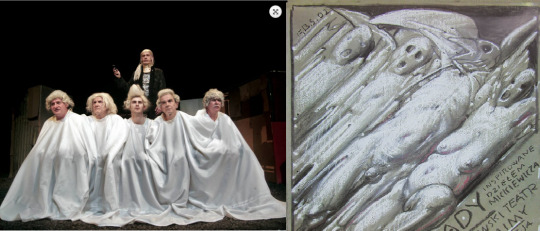
I had mention Saint-Just and there he is, in the background of the picture, symbolically assisting Danton and his clique in their last moments. Instead of shwoign them in torn shirts, the director went into another direction altogether and enshrouded them in white sheets from heads to toes, making them all look like very stereotypical ghosts, whom they will all become in just a couple of moments.
In Polish culture, the first thing that comes to mind when talking about ghosts is Dziady, an old slavic tradition that is now replaced with the Catholic All Souls Eve. Dziady is no longer, apart from perhaps some small minorities who still practice old pagan faiths, but as a ritual, they are immortalised in a play by Adam Mickiewicz, undoubtedly the greatest Polish poet ever. Everybody know this play, some scens - by heart, and they were and are being staged pretty much constantly from one point on. Needless to say, they inspire a lot of art, and I decided to show this very fmous poster by the most famous Polish poster designer, Franciszek Starowieyski…

…who is important in this case, because he played David in Wajda's movie.
Not many people know - because his other carreer overshadowed by a lot his first one - that Wajda was a painter. Who actually hated his art, some of his pieces are in the national museum of contemporary art in Łódź alongside stars such as Władysław Strzemiński (the hero of Wajda's very last movie), which is a fact he absolutely detested. I dont know, nor do I care, why was that, because what matters is his previous education as an artist at the very least helped him not only to envision the visuals of the movie, but also acquainted him with great works of art. On which he could model this or that setup. I think it's a nice little detail he catsed Starowieyski as David, a real painter acting as another real painter, it adds a layer of reality onto the movie, and presumably makes for a more natural acting in the few scenes he was in his studio (I also think they look alike).
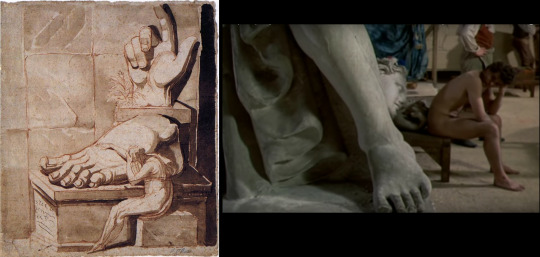
Speaking of David's studio, I once stumbled upon a lecture which drew parallels between some scenes in the movie and some paitings, which was mostly focused on character and costume design, and truth be told didn't contribute much to the overall watching experience of Danton. However, I must admit the lecturer had a very good eye in this one particular case, in which he pointed out that this quick shot in David's studio pretty obviously invokes the Fussli's The Artist's Despair Before The Grandeur Of Ancient Ruins. I don't think it's a coincidence (or at the very least, would be funny if it were) this shot is shown during the scene where Robespierre starts to grasp at desperate measures to save the country/save his own face in the trial. It is an artist's despair, only artist of a different kind. And it is a despair when being faced with a (possible) ruin of something great, even if its greatness is not yet formed, as opposed to the greatness passed.
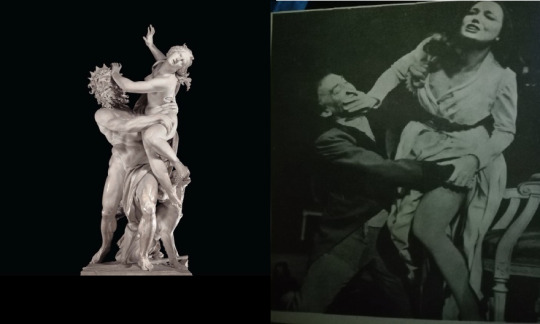
The very last example I was able to think of was this photo I found of The Danton Case from 1975. It is one of those old, very classical (I presume) adaptations, which are mostly filled to the brim with riddiculosly attractive people and very often deliberately drew from other sources of artistry, like the one pictured above. No matter what the real relationship between Louise Danton and her husband was, in the play it is portrayed as something atrocious, and I cringe whenever directors try to make it something else without good reasons for doing so, so I am very glad in the past at least they stuck with classicaly depicted acts of violation against women, not because it is a violation, but because in the classical stories (like the myth of Persephone shown in the sculpture above) the woman will usually get her revenge. Just like Przybyszewska's Louison did.
Thank you for bearing with me until the end, and if you have any other examples of this come to your mind, I compel you to share them with me!
List of pieces of art in the order of their appearance:
Jacques-Louis David, The Death of Marat
Franciszek Starowieyski, Dziady
Jacques-Louis David, Self-portrait
Heinrich Fussli, The Artist's Despair Before The Grandeur Of Ancient Ruins
Gianlorenzo Bernini, The Rape Of Persephone
#Stanisława Przybyszewska#stanislawa przybyszewska#andrzej wajda#the danton case#sprawa dantona#thermidor#jan klata#jerzy krassowski#jacques louis david#heinrich fussli#gianlorenzo bernini#art#ekphrasis#franciszek starowieyski#painting#sculpture#ekfraza#rzeźba#sztuka#Ekphrasis is my current hobby so I had to pull this together
38 notes
·
View notes
Text
My Best Friend’s Story (2020) Final Review
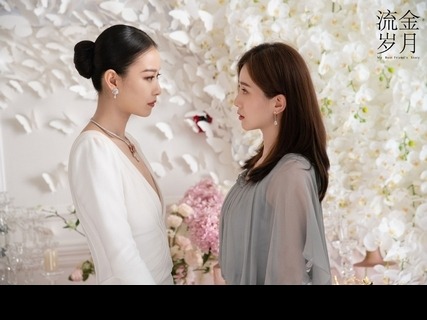
I’ve written two first impressions of this drama here (first episode impression) and here (episodes 1-7 impression). Beyond the first 7 episodes, I continued to enjoy the drama until episode 24 or so. But when Jiang Nansun returned from Italy, that’s when the drama started to go downhill for me. One good thing that I appreciated in this drama is that the personalities of the characters stayed relatively consistent, which is an accomplishment for cdramas. However, my gripe was with how the ambitions of the characters changed. Even though the plot was quite simplistic in the first half of the drama, it felt like Nansun and Suosuo were actively moving the plot forward. They had agency over their own growth. But in the second half, they were striving for things they didn’t want. Rather, they were coping with life stressors and making compromises. It might sound like a realistic depiction of the unpredictability of life struggles, but what was frustrating about the plot progression was that both Nansun and Suosuo made things harder than they had to be.
Jiang Nansun
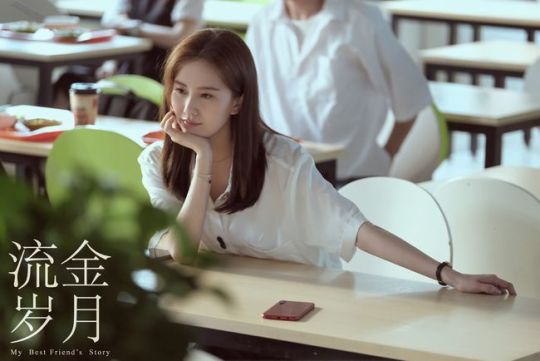
I actually really liked Nansun’s character development. She didn’t just grow for the sake of growing, but we see her potential of becoming someone competent and independent early on. This means that sooner or later, she would become a mature woman over time, but her father’s suicide triggered this growth sooner than expected.

Despite having an opposite upbringing from Suosuo, Nansun and Suosuo are actually quite similar in terms of their outlook on life and their judgments of people. That’s why they’ve managed to stay best friends for so many years. What’s different between them is that Suosuo has had to stand up and protect herself more often. This means that she’s used to being confrontation.

Nansun is a bit more reserved. She does things more underhandedly. She’s more of a schemer. When you see how she handled things with Yuan Yuan, we see how she’s not above lying and bribery to safekeep her sense of security. Even Suosuo was shocked about how cleverly and calmly Nansun was able to figure out the truth of her boyfriend’s past with Yuan Yuan.
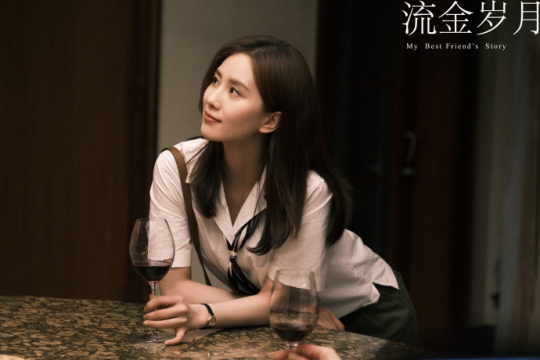
But, we also see that Nansun is also capable of being just as spoken as Suosuo. She openly bickers with Wang Yongzeng. She never hesitates to stand up to her dad. When you look at the women in Nansun’s life, you can see where she gets her gumption from. Her aunt is a level-headed, well-traveled business woman. Her mom is a self-aware but oppressed housewife. Her grandmother is an overbearing traditionalist. All three women are resilient, if flawed. Nansun may have had a privileged upbringing, but she’s capable of facing adversity and adapting to changing circumstances. It’s also because of these three women that forced Nansun to have to think for herself.
I think what a lot of people had issue with is how Nansun handled her father’s outstanding debts. She kept it a secret, refusing to tell anyone about it because she was afraid of burdening them. So, she took it all on herself. As a result, her aunt and her boyfriend misunderstood her and was disappointed that she would choose earning fast money over pursuing her passion. I’m still trying to figure out whether this decision makes sense for her character. Nansun justifies the decision by saying that she doesn’t want to worry and burden her loved ones like her father did. Nansun also said that telling Wang Yongzeng about her problems would just ruin his current passionate and carefree approach to life.
But one of the reasons why she broke up with Zhang Anren was because he refused to help her in her time of need because he didn’t want to be associated with her dad’s gambling habits. You would think that after having such as a selfish and unreliable boyfriend, she would expect her next boyfriend to be more supportive and compassionate. They writers even set up WYZ to be more compassionate. When he heard the news that Nansun’s dad came to the university to ask Zhang Anren for money, he called all the way from Italy to ask if he could help. So I thought that WYZ would be more involved when Nansun encounters another problem. But no. Instead, Nansun doesn’t even give him a chance to help her because she wanted to protect him from her reality and her struggles.
We then see a third love interest appear: Li yifan. He’s like a more genuine version of Zhang Anren. He plans everything to the T. He has a clear plan for the future. He’s reliable, dependable, and will guarantee a sense of security. He sees marriage as a contractual partnership, and romantic gestures are superficial. They’re just fantasies that you dreams about when you’re young, but they’re hollow and unsustainable. You know that if you marry him, you won’t have to worry about him being unfaithful and that you’ll always be provided for. He’s direct, transparent, to-the-point, and no nonsense. His ex-wife tells Nansun it’s important to find a man who’s is emotional calm and stable. He seems like a perfect marriage partner. I’ve seen lot of comments saying that he’s better suited for Nansun than WYZ is.
The thing is, while you can’t go wrong if you chose Li yifan, he doesn’t offer anything that Nansun can’t provide for herself. Back in grad school, Nansun liked Zhang Anren because he pampered her, and love and attention was something that she lacked from her family at home. But now, Nansun has learned to love herself and provide for herself. She’s able to give herself a sense of security, and she no longer needs a man to provide it for her. Instead, she wants a partner who is able to emotionally and intellectually stimulate her, and WYZ can provide this. He’s able to show her a different side of life. She’s able to have fun with him. He helps her grow and draws her out of her comfort zone.

Nansun likes WYZ not because of what he can give her, but because of who he is. That’s why even though he doesn’t help her overcome her obstacles (because she didn’t let him), she still loves him. She likes his personality, his values, his free spirit, his humour. She’s able to provide her own noodles, but he offers the spice.

The conversation that Nansun has with her aunt also becomes important. Her aunt says that marriage is just a confirmational contract, but it’s not the foundation of a relationship. That’s why her aunt doesn’t feel a need to remarry and is perfectly happy with just dating.
So in the voiceover during the final scene, Nansun says that she and Susuo continued to live together for the next 5-6 years, implying that she and WYZ didn’t get married. WYZ also mentioned a few episodes ago that marriage and starting a family wasn’t on his agenda. So we as the audience are left to assume that Nansun is following in her aunt’s footsteps and isn’t in a rush to get married or start a family. Just as long as she’s happy spending time with the one she loves, that’s all that matters. She’s finally broken out of her family’s traditionalist values after all and is career-driven.
Another note is that the library scene during Nansun and WYZ’s reconciliation in the finale was pretty romantic. In fact, I thought their whole relationship arc was cute and really enjoyed seeing it unfold. The chemistry just wasn’t quite there, but most couples in this drama lacked chemistry.
Zhu Suosuo

Suosuo had an anticlimactic character arc, but she was a pitiful character and arguably the emotional core of the drama.
She starts off ambitious, headstrong, but naive. She’s the Cinderella character: she’s stuck in her uncle’s judgmental home, dreaming of one day moving out and having her own family and being independent and successful. She’s tricked by a man, but it’s a blessing in disguise because it also puts her on the path of entering the Jinyan company. She finds quick (but shortlived) success as a real estate agent, and gains a reputation at the company. We see her gain momentum as she climbs up the ladder, getting closer to realizing her dream. But it all stagnates when she’s re-assigned to be Jinyan’s assistant.

She’s no longer running from client to client to try to recruit sales. Instead, she’s now stuck at the office, slowly falling in love with her boss who’s old enough to be her father. She doesn’t really do anything anymore but swoon over Ye Jinyan. And it gets cringey because she begins to assume that he likes her back and begins to act out of line, like questioning his decisions for the company and for his employees. When he scolds her for thinking too highly of herself and her influence in the company when she’s nothing more than just an assistant, she quits.
This points to a larger problem of the drama. What kind of lesson is the drama peddling? So far, for both Nansun and Suosuo’s storylines, it seems as though the drama is saying that as long as you’re young, pretty, and have rich connections, you’ll be fine. Most of Nansun and Suosuo’s problems have been solved by someone rich (usually Ye Jinyan). It’s unrealistic how fortunate and privileged they are. They knows so many influential people who are ready and eager to help them.
Another problem is how the drama villainizes people from the country and depicts people from the city as being morally superior. The prime example is Yuan Yuan. She’s portrayed as the greedy, scheming, love rival who wants to get in the way of all of Nansun’s relationships. At first, I was annoyed at how lazy it was to bring her back to try to steal WYZ. But on second thought, it was interesting to see how differently Nansun reacts to Yuan Yuan compared to a year ago, and how uninterested WYZ is in her compared to Zhang Anren. It shows that Nansun has matured. She’s no longer jealous of Yuan Yuan because she’s confident and secure in her relationship with WYZ, and she trusts him in a way that she couldn’t trust Zhang Anren. And that’s because WYZ’s behaviour makes him worthy of being trusted.
Yuan Yuan’s appearance also gives Suosuo a chance to show her rage and protective side. It was really satisfying seeing Suosuo call out Yuan Yuan’s intentions.
I lost interest in watching Suosuo’s relationship with Jinyan. By that point in the drama, Suosuo seemed to have lost her drive to further her career. So while she’s still as headstrong, outspoken, and flirty as ever, her ambitions have changed. I’m also trying to understand why Suosuo fell for Jinyan. Is it the idea of being liked by the most powerful man in the company? Is it because he’s aloof hard to get? She wants a home and family, things that he is unlikely to give. And yet, she’s drawn to him. Not Yang Ke who’s smart and not Xie hong zu who worships her.
What’s more curious is Jinyan’s side of the relationship. At first it’s ambiguous. He cares for her, but doesn’t show it outright. You then learn that it’s because Suosuo has the exact same birthday as his daughter who committed suicide, and he still blames himself for being an absent father. So he’s trying to repent by doing his best to protect and love Suosuo, whom he treats as a stand-on for his deceased daughter. But then there are moments that make you question that line of reasoning. He reminisces the time he spends with Suosuo. He accidentally calls his secretary by her name. He drinks to try to numb the pain of her absence. He’s enraged when she quits. He cries when gets she married (and it’s not the kind of happy crying that a parent would have, but it looks like a kind of regretful crying where he turns his back to the camera, takes off his sunglasses, and blinks the tears away). Or maybe it is a kind of worried parental crying because he knows that she won’t have a happy marriage with Xie hong zhu. It’s all very hard to tell. Does he love her platonically is romantically? Maybe a bit of both. He’s probably unsure himself.
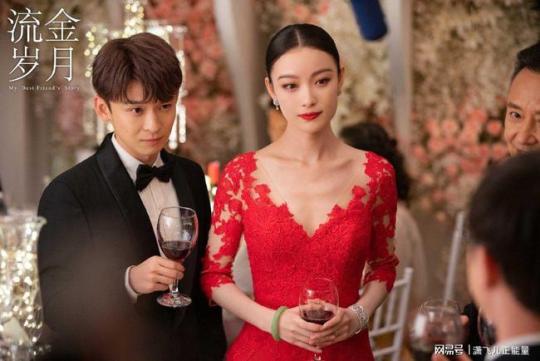
Suosuo seemed to jump into marriage with Xie hong zhu too quickly. She admits that it’s partly out of spite from being rejected by Jinyan, but it’s also because she realizes that Xie hong zhu is probably her best choice now. Suosuo and Nansun’s lives seemed to have switched: at the beginning of the drama, Nansun was the one who dreamed of romance and marriage, while Suosuo dreamed of freedom of success. Now, Suosuo is the one who’s eager to find a romantic partner, while Nansun is trying to find a foothold in her profession. But when you think about it, that’s who’ve they been all along. Even though Suosuo said that romance is a lie and an unreliable fantasy, a part of her still hopes to find happiness with someone who truly loves her. Nansun starts off having a seemingly devoted boyfriend, so romance was never something she thought she lacked, which was why in the end, she was able to figure out what she really wanted out of her love live. My mom always tells me to find someone who loves me more than I love them. Suosuo seemed to have taken this route. I think that you should love someone because of who they are, even if they might not love you back. Nansun was lucky to have found someone she loves who loves her back. Suosuo wasn’t as lucky.
After a long and bumpy road, Suosuo finally returned to basics and is working in sales again. But I was just disappointed at how they stunted her career growth just as she was rising.
Nansun and Suosuo’s relationship
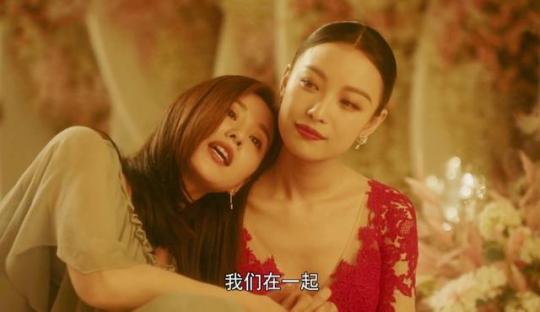
My initial criticism was that they weren’t really involved in each other’s lives. But that changed when Suosuo leaves her uncle’s place and is taken in by Nansun’s family. And then Nansun’s family falls into financial ruin and Suosuo takes them in her new place. And then Nansun’s father dies and her mother leaves, leaving only Nansun and her grandmother, whom Suosuo treats as her own grandmother. And they get even closer when Suosuo has a baby. So we see how they get closer and closer through all the problems they face together. But it’s obvious and predictable how devoted they are to each other. So whenever one makes a sacrifice for the other, it’s never a surprise. It’s very sweet and comforting to watch though, and the drama is worth watching for their friendship dynamic alone.
A lot of people criticize Liu Shishi’s acting, and while I also don’t find her to be a strong actor, I think she has good chemistry with Ni Ni. They balance each other out. They both have so much grace and composure. I also really like how evenly split their storylines were. Soulmate and Last Romance seemed to be biased towards the bubbly character more (i.e., Zhou dongyu and Cherrie Chung respectively), but in this drama, no lead had more screen time or priority than the other.
The male leads
Nothing needs to be said about Chen Dao Ming. He’s untouchable. I’m not even qualified to talk about him. Dong Zi Yan did the best with the script he was given. He was childish, immature, lovesick, hurt, conflicted, remorseful. You felt sorry for him even though he was an unlikable character. Tony Yang had a flat character, so he wasn’t given much to work with, but his Taiwanese accent was distracting, and I’m not even a fluent mandarin speaker, I’m cantonese. So it must have been more annoying for native speaker. A lot of people complained about him, but I think he looks good in modern day clothes, and he fits the role of a casual, laid back, handsome architect well. He looked terrible and sleazy in The Rebel Princess though.
Supporting characters
Fan Jin Gang, Yang ke, and Xia Qian (the aunt) are definitely people you want to have in your life. They are infinitely wise and compassionate, but very blunt. Yuan Quan definitely embodies the worldly aunt stereotype. You wish you could be her when you grow up.
Overall, I would say that this is a good drama. Probably a 7.5/10. It’s really slow, but I didn’t skip any scenes. I started watching it for Liu Shishi and Ni Ni, and then I watched it for the relationships, and then I watched it for the conversations that the characters had. There are a lot of good life advice in this drama, and it makes you reflect on your own relationships with friends and family. It’s a thoughtful story.
The OST was great, the cinematography tried too hard to be nostalgic, and the outfits were fashionable. When they went to “Italy” you could tell that they just chose a European-style neighbourhood in China and then put in clips from Europe. The drama used the long, overhead drone shot that slowly pans out in the last scene of the finale. It’s such an overused shot. Off the top of my head, I remember that Lost Romance does this, and so does Ashes of Love, The Rebel Princess, and My Girlfriend is an Alien. While cheesy, I do find these drone shots pretty impressive, especially when you wonder where the rest of the crew is hiding. But I feel like this drama would have been better off ending with a montage of their lives 5 years later. After all, this is a drama about personal growth and the passage of time, so it only makes sense to see how much has changed in 5 years instead of being told in a voiceover. I know they wanted the last shot to be of Nansun and Suosuo standing together, but I think it might be more impactful to see them separated, but still staying strong despite the distance.
I could probably go on and an about this drama. You could go into a deep dive analysis about every character.
Ni Ni outfit appreciation:
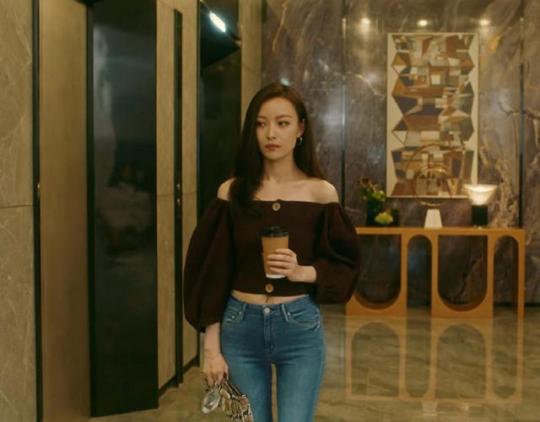
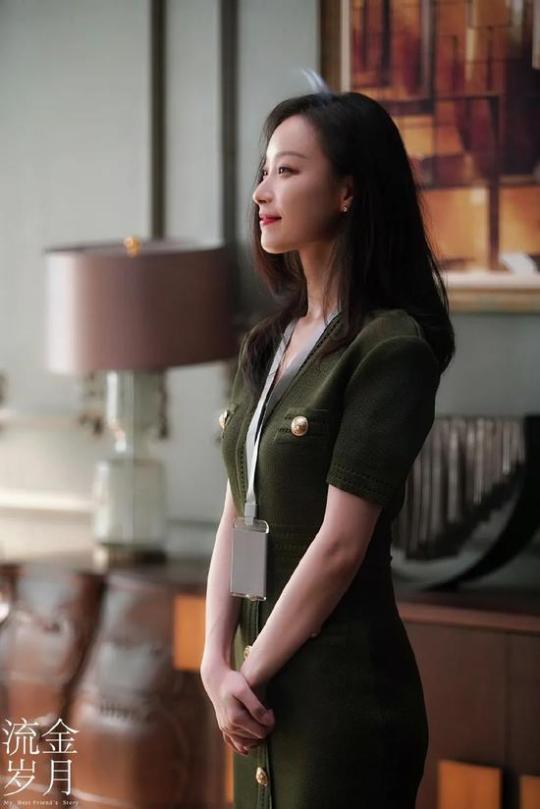
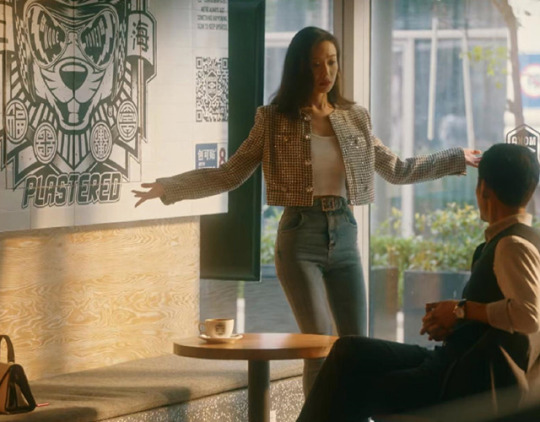
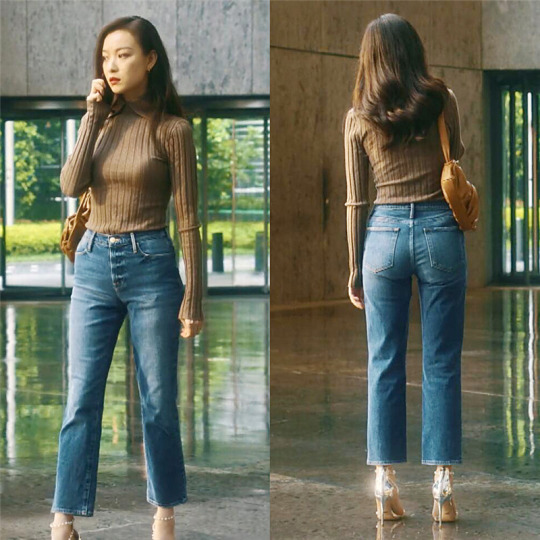
Here are the brands of some of the outfits.
16 notes
·
View notes
Text
Movie Meme
Took me a bit of time, but I was tagged by @bunnikkila to list my nine favorite movies, and since I can’t help but be ridiculously verbose about that very topic, you can see them all under the cut 8D
As for who I tag? Well, as always with the caveat that you are free to ignore if you don’t wanna, I’ll go with: @elistodragonwings @kaikaku @donnys-boy @robotnik-mun @sally-mun @fini-mun @werewolf-t33th @cviperfan and @wildwoodmage
and don’t worry, if you DO go for it, you don’t have to get as Extra as I did about it XD
9.)
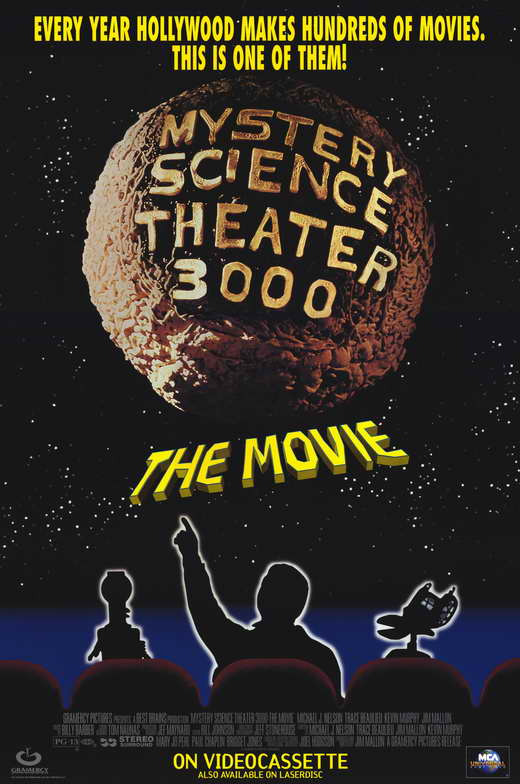
Look, the meme is about Favorite Movies, not necessarily the BEST Movies, OK? And for the most part this list consists of films where that division is less meaningful in terms of how I evaluate the other movies on here. But in this specific case, “Mystery Science Theater 3000: The Movie”, which is ultimately not all that different from the “Mystery Science Theater 3000″ TV show it spun off from and thus not particularly impressive as a work of Cinema Qua Cinema, makes the cut primarily because it’s a movie I know so well and have enjoyed so often that I can practically recite the whole thing to you by rote; I quote it all the time in my day-to-day life, I think about it often when I need a little smile, and it’s also become my favorite tool for introducing newcomers to MST3K as a whole since it was designed with a slightly broader audience in mind than the more willfully-eclectic series. And given how much I love MST3K As A Whole, that’s an especially strong factor in its favor.
8.)

Looky looky, @bunnikkila, we (unsurprisingly) have a pick in common! I’m sure this is the one and only time THAT’S going to happen on this list. 8D
Y’know, nearly thirty years (and one fairly useless remake >_>) later, I think the thing that impresses me about “The Lion King” is just how much it is still able to grab me emotionally. Some of that is unquestionably tied up with how strongly I associate this movie with my family, all of whom it became very special to as a Shared Experience. But I also don’t know of a lot of people who haven’t had that same emotional experience with it, and that to me suggests there’s more going on here than just Nostalgia. The mixture of Shakesperean plotting with Disney’s signature strength of Character, for one thing, granting the movie’s story an Epic Scope that never forgets the emotional inner lives of its cast. The music for another, not only its instantly-iconic song-book but also its memorable score, armed with both Big Bombast and Gentle Sentiment. And the unforgettably gorgeous animation, rendering every last element of its world with believable naturalism and strongly-defined personality. All of it, together, makes for what I still personally consider the Crowning Achievement of the Disney Renaissance.
7.)

I think, if I had to name the thing I find most lacking in far too many modern Action Movies, it’s Clarity. They all tend to lard their plots up with a bunch of unnecessary contrivances and complications in hopes of making themselves appear more clever than they actually are, and all it usually does is just dilute the impact of the whole thing. “Mad Max: Fury Road”, by contrast, is all about Clarity. I could sum up literally its entire plot in a paragraph if I wanted, because it is basically One Big Chase Scene from start to finish, never really deviating from that structure for more than a few minutes at a time. And that, combined with its exceptionally well-crafted Action Sequences, means that the full weight of its visceral power hits you full force every time. But don’t be fooled; that simplicity is not to be mistaken for shallowness. Indeed, precisely by getting out of its own way, knowing exactly what it wants to do and why, “Fury Road” also delivers a story that is, in spite of what you might guess, genuinely subtle and smart. Every character is immediately unforgettable and compelling because their role in the story is so well-considered and their personalities all so stark. The world it crafts feels at once fascinatingly surreal and yet All Too Real at the same time because even its most Fantastic elements are ultimately just grotesque reflections of things the audience knows only too well. And most of all, it tells a story with real, meaningful Themes that are deeply woven into each of its individual elements, such that the whole thing is deeply satisfying emotionally, but also piercingly Relevant in all the best, most affecting ways.
6.)

Oh look, another pick I have in common with @bunnikkila! This must be the last one, right?
But yeah, this is just a legitimately great movie, at every level, in every way. Stylistically, it is one of the most radically inventive things to have ever been made in the world of Western Animated Movies, gleefully mixing together a vast array of Aesthetics and Techniques that are at once viscerally distinct and yet coherently connected, all rendered with a fantastic eye toward the world of Comic Book Visual Language that keeps finding new and extremely fun ways to play with that instantly-recognizable iconography. For that alone, I would call it one of the greatest triumphs of 21st century animation. But then, on top of that, the story it tells is one that is simultaneously Arch and self-aware, delivering some of the most fantastically hilarious punch-lines imaginable more than a few of which are at the expense of the very franchise it is working within...but also entirely earnest, sincere, and emotionally affecting. It is, at once, a movie that manages to be about The Idea Of Spider-Man in its totality while also being about just one kid coming to grips with who he is, what he can do, and what his life can be. I don’t know that I can remember the last time a movie so immediately and unmistakably marked itself as an Enduring Masterpiece, but “Into the Spider-Verse” absolutely pulled it off.
5.)

Ordinarily, I would cheat and give this slot to the “Lord of the Rings” trilogy in its totality. But somehow, the fact that this is about “FAVORITE” movies instead of just what we think the BEST one is compels me to narrow it down to just one. And if I had to pick just one, it would be the first of the three, “Fellowship of the Ring”. It’s not necessarily anything that the other two movies get wrong, either. All three of the LotR movies possess many of its keenest strengths, after all. For a starter, there’s the keen understanding of how best to adapt the source material without being enslaved to it; capturing many of its most iconic moments while cleverly tweaking elements to make them more cinematic, knowing what scenes to focus on for the sake of more clearly focusing the emotional through-lines of the story, and knowing what scenes, no matter how good on the page, ultimately don’t fit to the shape the adaptation has taken. There’s also its pitch-perfect casting, each and every actor doing a fantastic job of embodying the characters so well that even as your personal vision of them from the books may differ radically from what is on-screen, they nonetheless end up feeling Right for the part and a strong, compelling presence. And there’s the deft visual hand of director Peter Jackson, who knows exactly how to craft a Middle Earth that feels at once lived-in and real but also Fantastic and magical. “Fellowship”, for me at least, thus wins out mostly because it has the good luck of being adapted from the strongest of the three books, the point at which the narrative is at its most unified and thus has the strongest overall momentum. But also because so few movies have so swept me away with the sense of stepping into a world I have always dreamed of in my mind’s eye, and that’s the sort of thing that can only happen at the beginning of a journey.
4.)
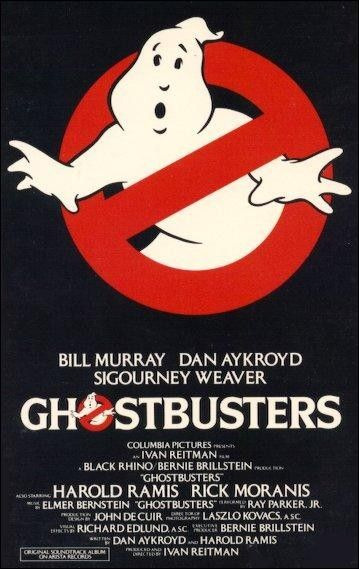
Now here’s a movie that is literally sown in to my very being. It’s the last movie my mother saw in theaters before becoming a Mom. I grew up watching the “Real Ghostbusters” cartoon all the time and playing with the attendant toys; I had a “Ghostbusters” Birthday Party when I was, like, four years old. It has been my annual Halloween Tradition to get myself a big Cheese Pizza and watch this movie for about as long as I’ve had disposable income to myself. There is, quite literally, no point in my life where I don’t remember “Ghostbusters” being a fixture in it. And as a nice bonus? It is, legitimately, a Genuinely Great Movie. I realize that isn’t quite as universally agreed upon these days as it was even a few years ago (thanks, Literally The Worst Kind Of Virulently Misogynist Assholes lD; ), but I still feel pretty confident in saying this one really is That Good. I still find basically every one of its jokes hilarious; even now I could quote just about any one of them and get a laugh. I still find its central premise, What If Exorcism Was A Blue-Collar Business, a brilliant, almost subversively clever one that takes The Supernatural out of the realm of The Unknowable and into a world where even you, an ordinary person off the street, can in fact fight back against it. I still think it’s one of the all-time great examples of how to balance Tone in this sort of High Concept Genre Bender, by allowing The Story to be played relatively straight while allowing the comedy to flow naturally from the characters’ reactions to that story, allowing its Ghostly aspects to land as Genuinely Scary (or at least Worth Taking Seriously) without getting too Stern and Serious about it. And I still listen to that unforgettable Title Song all the time! So yeah, even if I could be more objective about it, “Ghostbusters” would almost certainly make this cut.
3.)
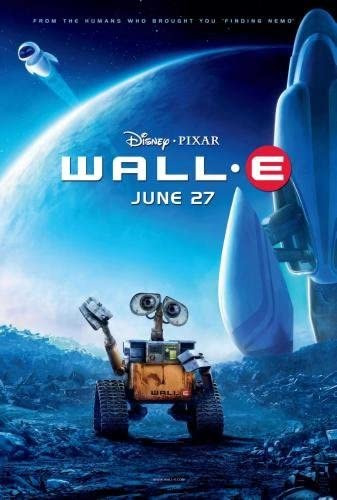
And so we come to the third and last pick I have in common with @bunnikkila, not coincidentally a movie that played a key role in solidifying our friendship, as bonding over our shared love of it was a big part of how we got to know each other on deviantART waaaay back in the day <3
By 2008, I really didn’t think it was possible for a movie or comic or TV show to really become “part” of me anymore, the way things like Sonic the Hedgehog or Marvel Super Heroes or Some Other Movie Character Who Might Be At The Top Of This List had. And then “WALL-E” came along and proved that to be completely, utterly wrong. I didn’t just love this movie, I was inspired by it, to a degree of strength and consistency that I’m still not entirely sure has yet been matched. And to be sure, some of that is undoubtedly because the movie had already basically won the war before I’d even bought my ticket; Adorable Robots In Love is something like My Platonic Storytelling Ideal, after all. But even setting that aside, “WALL-E” is a movie where even now I can’t help but be keenly aware, and gently awed, at the beauty of its craft; indeed, watching this movie in a theater did a lot to make me better understand why movies work on us the way they do, because I left that theater chewing so much on every last one of its elements. Its gorgeous animation, the way it conveys Character through Actions more so than language, the dream-like quality of its musical score (even as i type this i get teary thinking about certain motifs), the clear and meaningful way it builds its theme and story together so harmoniously, and the particular perspective it takes on our relationships with each other, with our environments, and with our own technology...all of it speaks to me deeply and profoundly, and it’s no coincidence that I have seen this movie more times in theaters than any other on this list (twelve times, for the record, and I still remember each and every time XD).
2.)

This one needs no personal qualifications, to my mind. Yes, I have some degree of nostalgic attachment to it for having seen it relatively young with my brothers and being deeply moved by it then, but it’s not at all like the kind of Nostalgia I have for “The Lion King”. “Princess Mononoke” is just flat-out, full-stop a complete Masterpiece, not just my personal pick for one of the single-best animated films ever made, but one of the best films period. It’s almost difficult for me to put into words how great this movie is, certainly in a way that hasn’t been repeated to death by thousands of other smarter people, because no one of its elements quite answers the question of why it is so great, to my mind. Yes, the animation is absolutely gorgeous with a design sensibility that brings Ancient Mythology to life so vividly that its influence can still be felt today (The Forest Spirit alone has been homaged all over the place). And yes, the music is hauntingly beautiful, at once capturing the gentle rhythm of nature but also the elegiac tone of Life Moving On. And yes, the story is an incredible mixture of the Broad Mythic Strokes of an Ancient Legend grounded in all too human Emotions and Ideas about the balance of nature, the full meaning and cost of Warfare, and perhaps most important of all, about how we determine Right and Wrong when everyone involved in a conflict is fighting simply for the right to survive. But all of those things add up together to something even greater than a simple sum, because each one isn’t just good in its own right but because each element so perfectly reinforces the other. And even having said all that? I really could just carry on singing this movie’s praises. Just...an absolute masterpiece, top to bottom.
1.)
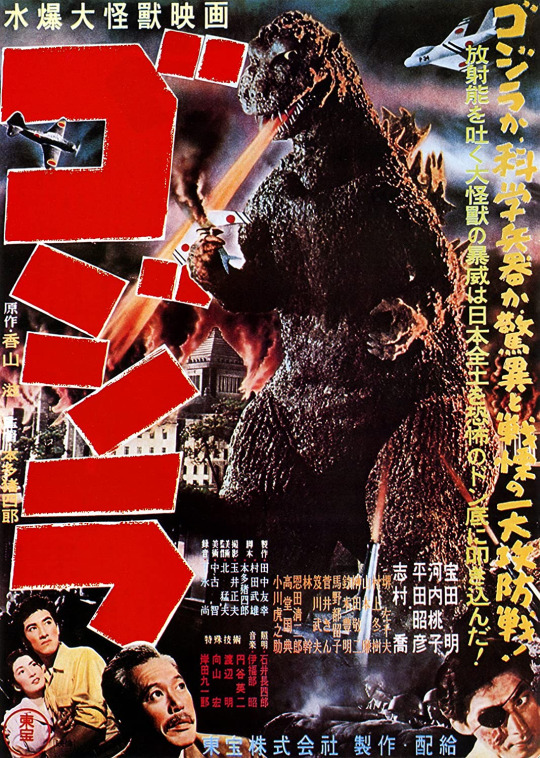
I don’t imagine any of you are terribly surprised at this, right? I almost feel like it’d be redundant to explain my love for this movie, given how self-obvious I imagine it is to basically everyone who knows me Literally At All. But heck, I’ve rambled on this long, why not go all the way? Because the thing of it is, “Gojira” (to be clear, the original Japanese movie from 1954 rather than its American edit, “Godzilla: King of the Monsters” from 1956) doesn’t just top the list by being a Great Movie. Though to be clear, it really is. Flawless? No; there’s a reliance on puppetry that even for the time can be a bit chintzier than the movie can really afford, in particular. But brilliant, even so, a heart-wrenching example of Science Fiction Storytelling As Allegory, one that, in a rarity not just for its own genre but indeed for many movies in general, very meaningfully lingers on its deepest, darkest implications. Many a film critic has pointed it out, and it remains true: the stark black-and-white photography heightens the sense of Implacable Horror at the core of the story, and the way the central Melodrama, a tragic love triangle that carries with it many aspects of Class Conflict and Personal Desire VS. The Collective Good, ties back into the main story is truly beautiful in its elegance and emotional impact. Still, for me personally, it tops the list, now and always, because it is a movie that affirmed something for me, that the character I had fallen in love with as a child convincing his family to watch a monster movie with him on television to prove his seven-year-old bravery, really was as genuinely as powerful and meaningful a figure as I had always imagined him to be.
3 notes
·
View notes
Text
Cats
Fuck me, one day into the new decade and I think I can safely say I won’t see a more bizarre film than this adaptation of the musical by Andrew Lloyd Webber and the poems by T.S. Elliot. The film has been universally panned and a HUGE box office bomb, and rightly so. It’s shite. In fact, it was a CATastrophe ayyyyyy
A theatre friend of mine told me that there’s no story to Cats. Maybe the theatre production is different to this because there is one in this. But it’s basically Britain’s Got Talent, just for cats. Once a year all these cats have a chance to impress Old Deuteronomy (Judi Dench) who will grant them a chance for a better life. Victoria (Francesa Hayward) is a new cat, recently abandoned onto the streets. She meets all the cats who want to perform. However there is a bad cat called Macavity (Idris Elba) who uses magic to trap the cats with a chance of winning to a barge in the middle of the Thames. He wants the chance for himself but eventually the down and out cat, Grizabella (Jennifer Hudson) wins. No surprise really, the contestants on BGT who have a sob story always gets more screen time. Disgusting.

(can’t find any gifs from the film so enjoy the random ones of cats)
Much has been said about how the cats look and yeah it does look weird. It’s really weird. Judi Dench looks like Aslan. And in all honesty, I did spend the majority of the film seeing if they forgot to cgi out any of the male actors bollocks. In my defence they did do a ropey job of the cgi, you could still see Judi Dench’s wedding ring and I swear I heard that there was a floating tail seen at one point. It was hard to get past how weird it all was and unfortunately it just ended up being a massive distraction. It made no sense, I didn’t know how the cats could do magic, that was never explained. The songs are shit and forgettable apart from Jennifer Hudson’s rendition of Memory, one of the few good things about this. And just the story in general, absolutely mad. Seemed to take an age for anything to happen, and some of the scenes along the way were pointless. The ending is perhaps the bizarrest part of all. Judi Dench sings/talk to the audience for about 5 minutes (felt like 30) and it’s so awkward. It’s horrible. Why. Why was this film made? What nutter agreed to make this?

Even in something as bad as this there are still a few OK moments. Sir Ian McKellen as Gus The Theatre Cat is great. He was just himself, just as a cat and you can’t get bored of his genius. Taylor Swift, who cleverly only wanted to be in it for 5 minutes was fun. And poor Francesa Hayward, the supposed star of the show didn’t have much to say but she can sure dance. And Ray Winstone turned up as Macavity’s sidekick. Not that he was good. But he’s a West Ham fan. I know, I’m clutching at straws.
1/5
Have I mentioned how weird this is? Even with a star-studded cast you can’t escape just how bizarre this is. Weirdly, I’d still recommend seeing it. Not because it has anything that great about it. Really just because you won’t believe how mad it is. Even though it is awful (it’s really bad) I couldn’t take my eyes off it. I think I’m still in shock.
#film#Film Review#movies#movie review#cinema#cinema review#new#cats#cats movie#francesca hayward#idris elba#judi dench#james corden#ian mckellen#jennifer hudson#taylor swift#rebel wilson
13 notes
·
View notes
Text
Ways of seing: found in translation

In 1972, the BBC broadcasted a four part documentary series called Ways of Seeing. In the show, John Berger, long-haired, wearing wild 70s shirts, portrays a charismatic host. Alternating between shots of Berger talking straight to the camera, close ups of paintings and advertising images that he analyzes and other sequences where he does not even speak, the series questions art and our relationship to it. Berger has a rather unusual approach to art history, instead of using convoluted sentences, he opts for a more conversational tone. Moreover, he draws parallels between high (Renaissance paintings) and low (advertising) - blurring boundaries and demystifying art in the process – in order to urge the audience to question the images that surround them on a daily basis.
In the same year, Pelican Books (an imprint of Penguin Books), released a book version of Ways of Seeing containing 7 essays, three of which use only images. The book was a collaboration between John Berger (writer and art critic), Sven Blomberg (painter and sculptor), Chris Fox (art critic), Michael Dibb (BBC producer) and Richard Hollis (graphic designer), and eventually became a classic amongst artists and graphic designers. Today, we mostly talk about how digital media is threatening print, so it is interesting to see something that started as digital find its real audience in print. It is a truth universally acknowledged that adapting a project to a different medium is not an easy task, but rather one that ends up losing the original substance in translation. Honestly, what can pages and typefaces and paper add to an on-screen experience during which everything is already said and seen? Ways of Seeing’s screen to page adaptation is unusual in that it maintains the essence and clarity of the original essays.
Above anything else, Berger criticizes artistic elitism. It make sense, then, that he did not want to follow art history’s elitist norms and watch his show get turned into an imposing coffee table book – affordable and understandable by only a lucky few. In regard to this, Hollis went on to design a revolutionary art book. Ways of Seeing is a slim and small paperback – 127 × 203mm – of only 166 pages. Famous artworks are printed in black and white, stripped of their daunting greatness. The first essay starts on the cover: “Seeing comes before words. The child looks and recognizes before it can speak.” It gives the book a sense of modesty and of urgency which also suggest a digital quality: the content is broadcast to the reader even as they pass the book on a shelf, just like a viewer would see part of a show while flipping through TV channels.
The inside of the book is as striking as the outside. Gone is the nod to classicism, the book screams modernity. Hollis sets the entire book in a bold sans serif font – Univers 65 – in order to match the visual weight of the illustrations. The text is broken down into short bursts, usually no more than a paragraph, and the images are inserted into the running text column, so they become part of the story, and do not break the flow of reading.
The text and the pictures work simultaneously, like a continuous stream of images on a TV screen. When adapting Ways of Seeing into book format, the designer cleverly uses the limitations and conventions of print. In the show Berger uses silence as an active agent of change in how we see things, in the book, turning a page serves the same purpose. For instance, he places place a Van Gogh painting at the bottom of one page with the caption “Look at it for a moment. Then turn the page”. When the reader does so, he finds the same picture at the top of next page, accompanied by another caption: “This is the last picture that Van Gogh painted before he killed himself”. This simple trick illustrates Berger’s point of the impact words can have on an image.
Finally, as Berger himself states in the series “seeing comes before words”, so he sometimes stops talking, and lets the juxtaposed pictures on screen speak for themselves. Hollis manages to recreate that in entirely visual essays where he stops using type to pass on messages and lets the visuals do the talking. He puts starkly contrasting images – such as advertisements promising a life of luxury and pictures of war refugees – side by side to denounce social inequalities. And so, the meaning is not lost in translation from screen to page, because just by flipping through the pages, seeing the interactions between type and pictures, the reader can already start to find some meaning.
0 notes
Text
Thirteen Reasons Why is Torture Porn; Using Graphic Violence to Make a Point
CW/TW: Mentions of suicide, rape/sexual violence, physical assault, and everything the Thirteen Reasons Why crew were told NOT to do by mental health experts
If you are in a crisis, don’t let a poorly written TV show tell you what to do; call the National Suicide Prevention Lifeline at 1-800-273-TALK (8255) or the Suicide Crisis Line at 1-800-784-2433. Surround yourself with people who will support you without judgement and are willing to take the extra step to understand. If you’re struggling to find regular mental health resources, check out here for more options. You still have a life ahead even if it takes some trial and error to figure out what the hell to do.
So Netflix released the second season of Thirteen Reasons Why, and, what a shock, people hate it for upping the graphic violence and rape. I have no plans to watch it myself after reading through all the triggers, but suffice it to say that so little was learned from the first season. Plus, I’d rather not subject myself to that much distress for a TV show I knew there was no point in continuing after the first season. Everyone’s accounts across Twitter and Tumblr of the new season seem to match up, so I’m going off of that for this piece.
If you haven’t seen my review of the first season (with and without spoilers), I found that it definitely went too far to make a point and had really confusing characterizations, but there were select scenes, when they were done right, were kinda worth the wait-- keyword being “kinda.” There was a germ of an idea begging for good writing, but got sucked into shock value for the sake of shock value. And the second season offers no promises to improve.
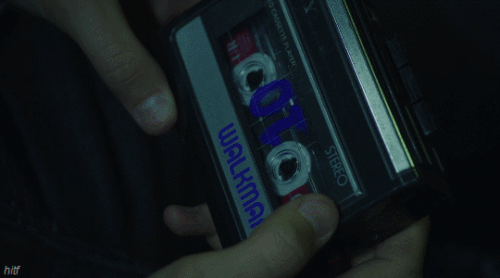
Of the multiple graphic scenes of this season, the one which sparked the most outrage was the final episode “Bye” as Tyler (a serial stalker) is brutalized and raped by his male classmates. As a result of being pushed too far, he brings practically a whole arsenal of guns to shoot up the school during a dance, but Clay peacefully disarms him before he can go through with it.
So apparently the creators saw the criticism of season one and thought, “So, you want to see more graphic violence, rape, and terribly confusing characterization?”
In an interview with The Hollywood Reporter, creator and showrunner, Brian Yorkey, wanted to explore more of Tyler’s psyche and “how a troubled man might be driven to consider this very difficult choice” after the bullying and ostracization he experienced in the first season. While I’d never wish rape on anyone, even fictional people--and a bunch of characters who mistreated him are total hypocrites--, Tyler is still beyond redemption for never understanding how his behavior destroyed Hannah’s sense of safety. The show puts him through that much brutalization to force audiences to feel sympathetic towards him while never critically analyzing why his stalking and coping mechanisms were wrong and unhealthy, regardless of what else was going on in his life.
It also promotes the dangerous idea that social outcasts and/or victims of bullying are likely to eventually become school shooters, which completely ignores factors like toxic masculinity or racist associations-- as was the case for shootings like Parkland and Santa Fe from this year-- which contribute to a white male sense of entitlement. Even though the lapses in logic are all over the place in the show-- particularly Clay having an emotional breakdown with Tyler, even though he made things worse in the first place by sharing revenge porn--, people had every right to distance themselves from Tyler as much as possible.
He’s a creep in how he objectifies his female classmates, constantly collects sensitive photos for blackmail, and his main outlet for anger becomes shooting guns at bottles and live animals, because society as a whole tends to only show men how to be emotional through anger and nothing else. This doesn’t help that when he testified, he apparently wanted to befriend Hannah to take photos of her to which she rejected (rightfully so) and thus his stalking began. It’s already so back-and-forth among viewers if Hannah committed suicide out of revenge or actual mental health deterioration, and subtly putting blame on her for rejecting Tyler is up there as one of the worst things they did to her. Not to mention throughout the second season, Tyler is anonymously putting up polaroids around the school of incriminating evidence in the case, particularly with Jessica, who is already stressed as is coming to terms that she was raped by Bryce.
It’s upon these scenes that I realized Netflix’s Thirteen Reasons Why can’t decide who it’s supposed to be for. It’s not for teenagers with how unrealistic and unidentifiable the characters are, especially coming from an adaptation of an 11-year-old book with an outdated understanding of teen mental health, bullying and suicide. It’s most definitely not for mentally ill folks with a history of suicidal thoughts because it’s so graphic, violent, and triggering, and on top of which, is grossly inaccurate on how depression works. Are they making it for the same people who can stomach Game of Thrones easily?
Above all else, does graphic violence have any point in film or television?
As mentioned in their first Beyond the Reasons special, the writers argued about needing that authenticity for Hannah’s rape and suicide scenes “to be painful to watch,” but it’s really not worth it if it has nothing else to say besides “look at this excess violence; you need to feel bad.” If you need to spoon feed your audience an explicit rape or suicide scene to emphasize how horrible those things are, it’s bad writing. They made the same mistakes with Tyler’s brutalization, which like I said, only exists to make you feel sorry for him and almost forget he’s an irredeemable character.
Film and television are super creative visual mediums; there are ways to convey an emotion or theme without triggering content or alienating your supposed intended audience.
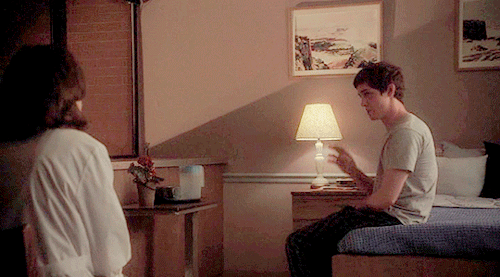
I mentioned this before in my first review, but Perks of Being a Wallflower did incredibly well in portraying child molestation and an attempted suicide without going too far. The scenes of the molestation are cleverly cut and mostly in shadow where all you can see is Charlie’s aunt rubbing his leg and hear her whispering “Don’t wake your sister.” And when he’s mentally breaking down and suicidal, the camera just pans to the knife slowly before immediately cutting to the police breaking in, and then Charlie wakes up in the psychiatric ward. It’s a gut-wrenching scene every time, but it’s also smart in remembering the intended audience and walking that line before it becomes too much. It’s a great depiction of an anxiety attack where everything overwhelms you at once, and sometimes there’s gaps in your memory in what happened while in that state of panic. It’s never addressed what happened between the police arriving and Charlie waking up in the psychiatric ward. But it doesn’t need to give those answers; what matters most is that Charlie is safe and finally going to get the help he needs.
A scene can be way more powerful in what it omits rather than what it explicitly shows. What you imagine might happen can be more exciting and/or terrifying than what any director could have put on the screen themselves.
Early horror and thriller films are among the most successful of this, especially if they’re directed by Alfred Hitchcock, the Master of Suspense. Sure, these films seem pretty cheesy when we in the 21st century are used to seeing much more violence and body horror, but they have their mark on cinematic history for a reason, and for an audience in the 1960s, this was horrifying. Take the famous shower scene from Psycho.
youtube
Instead of showing the knife penetrating flesh, it’s all edited in near-rapid cuts of “Mother” missing, Marion screaming and trying to defend herself, and shots of her feet with blood dripping into the water. It focuses more on the vulnerability of the situation, when there’s no chance for escape as you’re cornered against the wall and how quickly it all happens before you can react, complete with fast-paced editing and those high pitched violins. That kind of defenselessness freaked out actress Janet Leigh so much that she couldn’t take showers again without locking the doors and windows and leaving the shower door open. Hell, that still tends to be a common reaction for a lot of people who see this movie, and all without needing to show actual stab wounds.
And this trick in omitting some elements and highlighting others works well across genres for any scene motivated by any strong emotion. There’s probably about 50 different Disney films I can cite that do this well, but the one that sticks out the most is Tarzan.
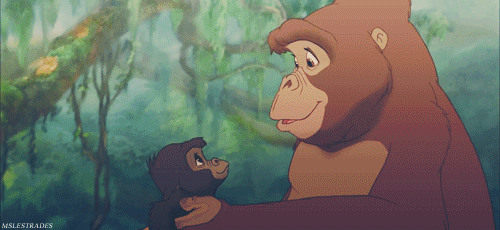
Aside from Phil Collins singing, some animal noises, and a baby cooing, there is no spoken dialogue for the first 7 minutes, which is a really long time for an animated family film. Yeah, the song kinda hamfists in the themes of family and love from the get-go, but it’s otherwise a great introduction. You see these two families just starting out before they’re cut short by tragedy; one with the death of a baby gorilla and the other with the death of Tarzan’s parents, both at the jaws of Sabor. The former is only indicated by the sounds of the baby gorilla’s screams echoing in the jungle while we only see the aftermath of the latter through Kala’s perspective when she finds Tarzan.
Obviously with it being a Disney family film, they’re not going to actually show Sabor tearing up a baby gorilla or the human parents. As such, they have to rely on context clues for the audience to pick up and piece together everything else with their imaginations. When you think about it long enough, it’s a really dark beginning on how quickly unexpected tragedy can destroy everything you hold dear. And it’s all accomplished without going too far.
Does this mean we need to omit graphic violence entirely for a film? Not necessarily as it very much depends on what the film is and your target audience. But omission is a great practice in a story to explore what else you have to say besides “Look at this traumatizing shit. You should feel bad.” Of course, we’ll always have mindless films which just exist to be violent, and historical narratives and/or social commentaries in some cases need violence to portray the reality of a situation. But when you’re making something about mental illness with intent to help those like your characters, it helps to listen to what your audience and mental health experts actually want to see in such a narrative. And like I said before, the Thirteen Reasons Why creators completely ignored criticisms of season one and continued making the same mistakes just to milk their product beyond the source material. It has nothing else to say or do besides being needlessly gritty as opposed to creating likable characters or understandable motivations.
The only exception to this rule I can even think of is Deadpool 2.

I know it seems counter-intuitive to compare Deadpool 2 and Thirteen Reasons Why given the former’s more excessive violence, but bare with me here. I stand by that Deadpool 2 is way better at handling themes of suicide and violence in two hours than Thirteen Reasons Why ever did in 26 episodes.
The major differences? The intended audience’s expectations and well-written characterization.
Most everyone going in already knows what Wade Wilson is like. And this is definitely not the first time he attempted suicide in such grandiose and gratuitous fashion. The first film established itself as a wildly violent parody of superhero films, and the sequel continues that by poking fun at recent trends of these films going darker and grittier. In any other film, this would cross the line, but because it’s Deadpool, the excessively grotesque violence is to be expected. It succeeds in capturing the shock and dark humor (i.e Wade blowing himself up with his apartment, knowing fully well he can’t die) while still maintaining the weight of his emotional turmoil.
We actually get to know who Wade is and why he acts the way he does. There’s no drawn out mystery or fact-checking other sources or confronting side characters we don’t care about. We get his perspective alone, and that’s all we need to see his grief over Vanessa escalating to self-destructive behaviors and how he tries to find some family and meaning in life without her, even though her death is retconned in the end anyway. It’s all played for laughs, but you can’t help but feel sorry for Wade because he loved Vanessa so much, and they were a wonderfully sweet couple.
Another thing Deadpool 2 does significantly better than Thirteen Reasons Why is not forcing gray morality where it doesn’t belong, particularly when Wade tries to save Russell. It doesn’t matter if his actions lead to a horrible future; he’s just a traumatized kid who needs a proper family who will guide him. A lot of X-Men films try to play the heroes as the bigger people who are above murder and revenge. Yet Deadpool 2 doesn’t punish those like Russell with understandable hatred and motivations. It is very upfront that if you harm children, you deserve whatever hell comes your way-- which really hits home as Russell was put through metaphorical gay conversion therapy.
Meanwhile, I can’t even be bothered to care about anyone in Thirteen Reasons Why. The second season out of nowhere piles on excuse after excuse to justify the characters’ actions without them ever facing guilt or consequences. Anyone else with a remote chance at sympathy is just put through more emotional torture without rhyme or reason. I don’t care who has a drug problem, who’s gay, who dated who, the he-said-she-said, etc etc. If you’re trying to preach the ever-tired “it gets better” bullshit, when does it actually start to get better?
Sadly, Thirteen Reasons Why can’t find that point, and I don’t trust it will given how little the creators learned from the first season’s criticisms. They don’t care about creating a narrative to help mentally ill teens. They have nothing else to say or do than to make money and shoe-horned in so much graphic violence under the guise of being “authentic” to compensate for a tired Degrassi knockoff which would’ve disappeared if it wasn’t based on a well-known YA novel. Graphic violence in media is a tool to be used carefully, and of course it will vary project to project. But if it just exists to pad your “deep, meaningful” story instead of developing characters, motivations and relationships, then it’s cheap, lazy torture porn, and it’s bad writing.
If you enjoyed this analysis and what I do here, consider buying me a ko-fi to show your support!
#thirteen reasons why#13 reasons why#netflix#tv#tv show#graphic violence#deadpool#deadpool 2#tarzan#disney tarzan#psycho#alfred hitchcock#perks of being a wallflower#analysis#my writing#essay#opinion#editorial
4 notes
·
View notes
Text
Top 10 Best Films of 2017 - End of Year List
I did a mid-year ‘best of’ list, so it was only fitting that I returned to the format at the end of the year to run down my top 10 favourite films of the year. Only three films from my mid-year list remain here, which is a testament to what an incredible year it has been for film. As far as I’m concerned, 2017 has been a real banner year for cinema and it has seen the release of several all-time greats that I look forward to enjoying for many years to come.
Since I’m based in the UK there will be several notable omissions here (I still eagerly await films like Phantom Thread, I, Tonya and The Post), purely by dint of the fact that they have yet to be released in this country. Do look out for them in my forthcoming most-anticipated of 2018 list!
Honourable mentions: Custody, Brimstone, The Disaster Artist, Professor Marston & the Wonder Women, Call Me By Your Name
1. Star Wars: The Last Jedi, dir. Rian Johnson

While the placement of this film on my list may be resoundingly predictable (check out the total lack of bias signalled by my username!), the thrilling thing is that the film itself is anything but. The Last Jedi shatters the Star Wars mould to entertain new forms of storytelling and question long-held assumptions. It’s a shockingly meta story in how it questions the conventions of Star Wars - particularly those concerning lineage and its implications - but it is never meta in an ironic sense. There are no wink, wink moments, and while the past is investigated and questioned it is never mocked. Instead of descending into irreverence, The Last Jedi is meta in a way that feels absolutely necessary and justified if Star Wars is to remain fresh and vital as it moves forward. Bloodline and history do not have to dictate destiny in this new version of Star Wars - the heroes are those who understand this, and the villains are the ones who fail to grasp the same lesson. It’s a beautiful and intellectually rigorous movie, and I’m thrilled by how it elevates and re-contextualises the stories that came before it while pushing the characters and their relationships forward. I have no idea of where Episode IX will take this story, and that is incredibly exciting to me. Bring it on.
2. Blade Runner 2049, dir. Denis Villeneuve

There are a million and one reasons why this movie shouldn’t have worked, but Villeneueve proved his genius by making a sublime sci-fi picture that actually surpasses its predecessor. I have always admired the original Blade Runner more than I’ve enjoyed it, and that’s because I have always found it emotionally distant. Deckard struck me as a mumbling arse and his romance with Rachael always felt obligatory, not organic. The genius of Blade Runner 2049 lies in how it made me care - it made me care about the love between Deckard and Rachael (which was something of a miracle in itself), and it made me care about the love between K and his holographic girlfriend Joi. With these emotional hooks in place, everything worked as a thrilling symphony. The cinematography is easily the best of any film in 2017 (sorry, Dunkirk - I still love you) and this film has an astonishing number of scenes that still linger in my mind after many months - the very modern threesome, the shootout in the gaudy pleasure palace, the fight in the rain, the father seeing his child for the first time. It’s a breathtaking film and I couldn’t be more excited to see what Villeneuve does next.
3. Dunkirk, dir. Christopher Nolan

Dunkirk is such a striking and effective piece of cinema that it actually made me overcome my innate bias against war movies (I blame too many tedious Sunday afternoons wasted on mandatory viewings of The Great Escape at my grandparents’ house). With Dunkirk, Nolan has probably made his most accomplished and sophisticated movie - it starts off unbearably tense and doesn’t release its grip on your pulse until the final scene, when its hero finally drops off to the blessed peace of sleep. Nolan employs a tricksy converging structure with multiple plot strands to ramp up the tension and provide different perspectives on the evacuation, masterfully playing them off each other to assemble the big picture. While criticised by some for its apparent lack of character, I can’t really agree with that assessment - Dunkirk is probably the most powerfully humanistic war film I’ve ever seen, and by stripping its characters down to their rawest selves it reveals some uncomfortable yet powerful truths about all of us. The characters are somewhat distant from us - we never hear them pine for lovers or miss their mothers - but the removal of these storytelling shorthands leaves us with soldiers who behave exactly as you would expect frightened, stranded children to. And there’s something terrifyingly poignant about that.
4. mother!, dir. Darren Aronofsky
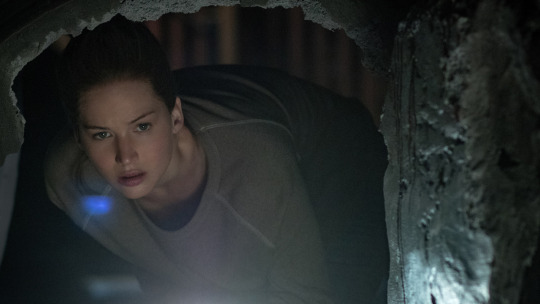
mother! is the work of a madman with no fucks to give, and it is what I choose to refer to as ‘peak Aronofsky’. He made what is clearly an allegory, and while he had his own intentions with said allegory (which he has been very loud about declaring) the film is so cleverly constructed that it can simultaneously be about the entire history of the world and the plight of the tortured artist’s muse - either reading is perfectly correct and supported by the text. mother! is a piece of art that has provoked a lively and frequently heated debate, and while it needs to be read as an allegory to make any kind of sense as a narrative I also don’t want to undersell this movie as an emotional experience. If you go into mother! willing to be challenged and content to be swept up in a bold artistic vision, it has the potential to be a really absorbing and engrossing film - it is anchored by Jennifer Lawrence’s remarkably brave and unrestrained performance. She is not playing a grounded character, but her performance is palpably real and frequently painful to witness - she portrays the whole spectrum of emotions, from mild bemusement to shrieking horror, and the whole film soars on the strength of her efforts. This is a uniquely strength and esoteric film, and I am incredibly happy that it exists.
5. Get Out, dir. Jordan Peele

This film really knocked me for six, to such an extent that I simply had to see it twice in the cinema. It got even better upon a re-watch, when I was able to watch it with full knowledge of the characters’ underlying motives and the things to come. It’s a terrifying concept (the racism of an all-white suburb is taken to a horrifying extreme) executed with incredible panache, and you feel every emotion that Chris goes through thanks to Daniel Kaluuya’s excellent performance. Get Out also represents one of the most brilliantly communal experiences I’ve ever had at the cinema - I won’t spoil it, but let’s just say that the audience erupted into spontaneous applause at a key moment in the climax. Simply fantastic.
6. The Handmaiden, dir. Park Chan-wook
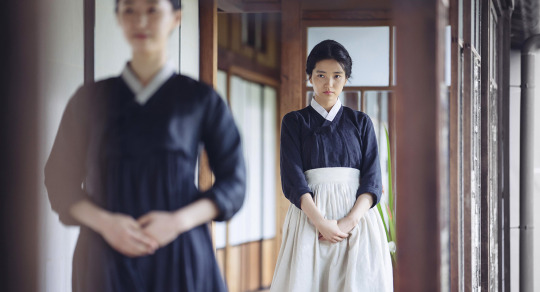
This film is exquisite - it’s first and foremost a beautiful boundary-smashing love story, and an absolutely marvellous tale of female defiance. It transplants Sarah Waters’ novel Fingersmith to 1930s Korea, and the story is effortlessly adapted to become intrinsically interwoven with its new setting. Sookee is a talented pickpocket plucked from a thieves den and sent as a handmaiden to trick a rich heiress into falling for a conman. To say any more would spoil the twists, but this film is just a masterwork of suspense, keeping you guessing throughout a series of interlocking pieces that take their time to reveal their secrets. I’ve seen the theatrical cut and the extended version, and they’re both great - you’re in for a treat with either.
7. The Florida Project, dir. Sean Baker

This is one of the best screen depictions of childhood I’ve ever seen. Our hero here is Moonee, a smart-tongued and cheeky six-year-old. Moonee lives in a motel room with her abrasive but loving mother, but since she’s a child she doesn’t mope or lament her poverty - she takes her surroundings for granted and makes the tacky shops and hotels that form her world her very own theme park. The Florida Project is firmly committed to adopting a child’s eye perspective, and while it can feel a bit meandering to begin with it gradually accumulates pace and purpose, building to an utterly heartbreaking and unforgettable climax. The performances here are extraordinary, and Brooklynn Prince is so palpably real as Moonee that she’ll own your heart by the end of the movie (having squeezed it to bursting point on several occasions).
8. The Shape of Water, dir. Guillermo del Toro
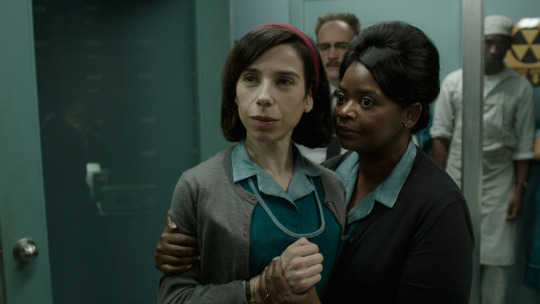
I’ve long been a huge del Toro cheerleader, and this movie is perhaps best described as ‘peak del Toro’ - it has the mannered, detail-oriented set design, the charming quirkiness, the subverted horror, and the woozily strange romance that he has employed again and again in his films. This story, however, is unusual for del Toro in that it is ultimately optimistic and hopeful - it’s the daddy of all supernatural romances in that it is a full-blown love story between a mute human woman and a fishman, and it is characterised by total commitment and self-belief. Think Creature from the Black Lagoon done with the creature as the romantic hero. The Shape of Water has a certain playfulness that means it never feels ponderous or silly, but it affords its characters real respect and dignity and makes you care for them deeply. This movie makes me excited to see where genre filmmaking can go next (hint: I hope it only gets weirder).
9. Thelma, dir. Joachim Trier

Who knew something like this could come out of Norway? This was probably my biggest pleasant surprise of 2017 in terms of film - I went in with no expectations at all, and came out wowed. This is an intensely strange and effective supernatural horror that follows a girl with strange repressed powers that manifest whenever she experiences desire. It could be a hackneyed or exploitative premise in the hands of a lesser filmmaker, but Trier shows a deft hand and a remarkable talent for building tension and creating a sense of heightened reality. There is one scene set to ‘Mountaineers’ by Susanne Sundfor that is one of the most transporting experiences I have ever had in the cinema - the combination of the ethereal music and the mounting suspense makes for real film magic. This was a great reminder of how important it is to take chances and try out films outside your comfort zone.
10. Jackie, dir. Pablo Larrain

This is a film that soars on the strength of Natalie Portman’s incredible performance, which is complemented by Mica Levi’s haunting score. Portman’s performance is painfully vivid, with her agony and wretchedness coming through so intensely that it’s often uncomfortable to watch. Jackie is probably the best portrait of grief I’ve ever seen, and it sucks you into a famous historic event by providing an incredibly intimate perspective on it. This is great cinema, but be prepared for suffering.
#best of the year#film#cinema#the last jedi#blade runner 2049#dunkirk#mother!#get out#the handmaiden#the florida project#the shape of water#thelma#jackie
207 notes
·
View notes
Text
M. Night Shyamalan’s Greatest Magic Trick: THE SIXTH SENSE
When we think of horror storytellers it is extremely easy to associate them with a specific sub-genre and style. Wes Craven birthed a slew of slashers in different periods of horror with both A Nightmare on Elm Street’s Freddy Krueger and Scream’s Ghostface, James Wan continues to construct a word of haunted homes starting with Insidious, Alfred Hitchcock trapped us in suspense with his first person point of view in Psycho. What comes to mind when you think of M. Night Shyamalan and The Sixth Sense?
The twist.
A few simple maneuvers here and there, a slip of the hand, a purposeful distraction, and a finale leaving us shocked, guessing how we could have missed such important parts of a sequence happening right before our very eyes only to be truly fooled in the end. It’s a magic trick, you see? A trick that can’t be taught and most certainly cannot be duplicated, its secret buried in the mind of a master, or so we thought.
Today Shyamalan shares his birthday with the theatrical release of The Sixth Sense, a great cinematic illusion that opened his mysterious act nineteen years ago, yet still demands the spotlight time and time again.
youtube
The Setup
The Sixth Sense reeled eager audiences into theaters back in 1999, a year when horror pulled back its curtains to unleash a variety of new sub-genres ranging from Japanese adapted tales with The Ring, to highly stylized period pieces with Sleepy Hollow, to found footage releases with The Blair Witch Project. The shine of the 70’s classics was, forgive me, beginning to dim, the slasher formula was exhaustively recycled, and garish science fiction had lost its appeal. With the dawning of an exciting millennium approaching, a new wave of filmmakers began to pave the road of the unique with the greatest showman, Shyamalan, leading the way.
By now you’re surely educated on The Sixth Sense’s plot and are aware of the third act twist that reanimated horror from its stagnant evolution, but if you are not I beg you to do two things now: One, do not read any further than my next plea as there will be spoiler content, and two, contact me immediately so I may study your reaction after I’ve convinced you to finally watch it.
We all know the story written and directed by Shyamalan, but in case you need a reminder: The Sixth Sense focuses on child psychologist Dr. Malcolm Crowe, played by Bruce Willis (Die Hard), who is attacked by an old patient, Vincent Grey, played by Donnie Wahlberg (Dreamcatcher) after therapy treatment yielded no results in helping his “possible mood disorder”. He takes on a new patient after some time off in Cole Sear played by Haley Joel-Osment, a lonely sad boy who later reveals to Malcolm that he can see the spirits of the dead. As the two bond, Cole’s anxious mother Lynn played by Toni Colette (Hereditary) grows worried by her son’s behavior, and Malcolm’s wife Anna, played by Olivia Williams (Rushmore), grows colder towards him, their marriage borderline estranged. Malcolm concludes that Cole shares the same gift that Vincent had, realizing the only way for Cole to be fearless of these ghosts is to listen to them, helping them cross over from this life. What he does not realize is that he is one of them, having been dead since Vincent’s attack all along.
Whether you are a fan of his work or not, Shyamalan changed horror in more ways than one. His directing style – with single character angles, long drawn-out shots, and engaging dialogue, sometimes dubbed over a secondary occurring scene, was, and still is, freshly artistic and captivating. He signs his pieces with a twist you never saw coming, each ending laid beneath a veil intricately stitched with masterly duping mechanics and expertly hidden exposition.
After giving The Sixth Sense a very thorough viewing, I decided to aim this ‘look back’ at one of horror’s most discussed films by laying out Shyamalan’s deliberate techniques, of which there are three: the first, obviously being the twist ending, the second is sudden “jump scares” throughout a relatively slow-paced story, and carefully placed audio pops contrasting with mostly quiet ambiance. It was not until I tuned my attention in on one scene in particular, possibly the least tense scene of the whole film, that I noticed how purposeful those specific techniques are and how he cleverly disguises this formula for all to see.
Ladies and gentleman, I give you…
The Coin Trick.
Malcolm, being surprisingly uneasy around children given his profession, attempts to connect with Cole using a magic trick. He shows the boy a penny, claiming he will make it disappear from his right hand to his left hand with a Clap. He continues with a shake of the left hand (now supposedly holding the coin) and taps his jacket pocket, claiming the penny is now inside, magically transported. The end of the trick comes with him repeating the first step in reverse with the penny winding back where it started from, in his right hand. Cole is a little nonplussed, taking it for a joke and foiling the magic by letting Malcolm know he’s aware the penny never left his hand to begin with.
The joke is on us. What appears to be a charming scene interpreted as an appropriate chaism for the film’s events specifically, I found holds even more weight when looking at Shyamalan’s work as a whole combined with his first-born masterpiece. The whole film is one big coin trick, one he’s been pulling on us for well over a decade.
Let’s peek behind the curtain.
Loud Claps
In the nearly two hours of runtime of The Sixth Sense, there are maybe only 7 minutes where the volume peaks over a whisper. And that includes its creeping score. Shyamalan advances this silence technique by working it with its significant other: booming interjection. I never noticed how sudden these loud pops of sound were until turning this on for a family movie night, my mother asking me to turn the volume up continuously throughout the first 10-minutes. Once we reached a comfortable level of being able to hear the soft dialogue, the first boom interjected: Anna’s gasp when Vincent’s shadow falls over her and Malcolm. Her quick, loud shock wailed through our television resulting in a few of our own follow-up yelps. Through Vincent’s angry screams and even the gunshot, we aren’t as shocked with sound like that of her gasp ripping through the quiet.
We’re met with that shock again almost 15 whole minutes later when Lynn enters the kitchen to find the drawers and cabinets hanging open out of nowhere. Long drawn out moments again filled with a murmuring tone only to be shattered by her jolting gasp. Another 20 or so minutes build up tension forcing us to pay attention to the characters and their conversations and we’re hit with the Stuttering Stanley scene. The intensity and the sound bursts into the scene, our hearing now completely out of focus. How about that balloon pop in conjunction with Cole’s screaming from the cupboard during the birthday party scene? The rock through Anna’s shop window? Each time the score’s instrumental pang comes out of nowhere as a ghost is suddenly present in a scene? All separated by consuming, purposeful quiet.
“The intensity and the sound bursts into the scene, our hearing now completely out of focus. “
With each segment of the coin trick, Malcolm makes a gesture with his hand, whether it be a wave or a shake, but his sudden clap is what throws the observer off-key. It’s a simple method, complete misdirection. The observer is busy keeping track of the movement when a sudden, loud CLAP interjects to knock them off their game. What happened? Did I miss something? Wait, where did the coin go?
Sudden sounds, especially as we are conditioned to regular low, mellow notes over time (well over an hour’s worth), are used to distract us as viewers. It’s a tactic necessary to draw our attention inward, slowly and steadily leveling our consciousness, before the interjecting boom blares the nerves out of us just as the claps throughout the coin trick do to the observer.
Waves and Shakes
As we’re relating Shyamalan’s cinematic moves to that of the coin trick, what some would consider “jump scares” mimic Malcolm’s wave and shake of the hand. These movements are the meat of the sequence, and they’re not particularly ‘jumpy’ in terms of action, but rather suddenly riddle us with fear. The Sixth Sense is full of waves and shakes, scenes created to develop the plot and warm up the brain.
We can separate a few of the slower monotone scenes from the ones that build in potency as the dialogue moves along, i.e. the “I see dead people” scene. The potent scenes, the waves and shakes that make up this film are Shyamalan’s most relied upon actions intentionally crafted with the end in mind.
Vincent’s scene at the very beginning, the wrist-cutting woman, the boy who was wreckless with a gun, the hanged fugitives, Stuttering Stanley, Vincent’s therapy audio recordings, and each scene with our semi-final ghost played by a young Micha Barton (The OC, Homecoming), Kyra, are all pieces of subject matter moving us towards the filmmaker’s endgame. Subject matter that is relatively scary to audiences honing in on those parts of the brain that force us to think about what’s happening.
Each of these scenes are building blocks adding one to the other as we reach The Sixth Sense’s end, yet each measured in simple, almost stabilized intensity. They are the movements of our sequence begging our attention and keeping us focused as the trick is being carried out before us.
Now, we give the penny another little shake, this one in particular being the scenes related to Kyra and Cole overcoming his fear to help her, as the coin has mysteriously made it way into Malcolm’s pocket. Problem solved? The end, right?
“But that’s not the end of the magic trick.”
End at the Beginning
Malcolm gives one final shake and clap ending with the penny magically returning to his right hand. The subtext of this simple trick’s ending being that we’re right back where we started from. What Cole so appropriately points out is that Malcolm had the penny in his right hand the whole time, it never went anywhere. Cole is the observer of the crowd pointing out the truth behind the artifice of the magician’s act.
This comes across to the audience as Cole being the all-seeing entity of the story. He can see the dead, and therefore can see through the trick’s ploy. But what his deadpan comment suggests further, is that it is Malcolm himself who holds the key (or the penny) to the sequence of this story. It begins with his death and ends with his death, the whole twist of him being a ghost stuck among the living throughout his time with Cole running parallel to the penny remaining in his hand through the whole trick. He aids Cole in coming to terms with his fear of listening to the ghosts that haunt him, all the while Cole is aiding him through the afterlife’s ascension. Like the coin, Malcolm never moved onward from where he began in the first place, needing Cole to point out the obvious in order to come to terms with this trick he has (unknowingly) performed.
The syntax of Malcolm’s silly coin trick runs linear with Shyamalan’s profound formula. Like unsuspecting observers hoodwinked by a magician’s cunning strategy, audiences experiencing The Sixth Sense, or almost any Shyamalan film, we are nimbly deceived by the shakes and waves of his scare tactics, thrown off by the unexpected claps of sound, and ultimately trapped in this chaism’s last twist with the prominent clues hidden by waves, shakes, and claps, finally exposed by the enlightened observer.
Repeat
Though many directors and writers have attempted to apply this method, it is my strong opinion that all films with a big twist ending pale in comparison to The Sixth Sense. As horror fans, we appreciate the common understanding that while there are great possession films out there, none can attain The Exorcist’s standards. Once a film has really broken ground in our genre by achieving that unique status, the films that attempt to follow in its footsteps will always remain beneath it. The Sixth Sense, like Shyamalan, leads at the forefront sheathing imitators and shams beneath its veil of success.
Shyamalan, being the experienced magician he is, recycles this trick throughout his career. However, what separates him from the one-trick-pony shows were often subjected to within the horror genre is that each time, this same trick is actually different. The sequence may remain, but Shyamalan has that special quality of shaking and waving the penny around in a multitude of ways that the only element we can expect when being participating in his audience is that, of course, there will be a twist in the third act.
Shyamalan is so skilled in the application of this coin trick that he can begin it by placing the penny in one hand and make it disappear… for 17 years before revealing it to be in that same hand all along.
After a scattered hiatus between the release of The Village in 2004, and the release of After Earth in 2013, the director seemed to fade into the background. Cue the dry ice and closed curtain, right? Many believed we had seen the last of the showman, that he had gifted us with his grand finale in his first release, until he reemerged relevantly successful with The Visit in 2015. Fans welcomed him, and his unmatched twist endings, back to the genre with open arms.
“Fans welcomed him, and his unmatched twist endings, back to the genre with open arms.”
The Visit wasn’t the only card up his sleeve. In 2016, Shyamalan pulled off the longest running coin trick in all of cinema’s magical history with the release of Split. I remember the slight feeling of disappointment run through me as the last few minutes of the film revealed no twist, just a well done, well acted flick. What happened to my penny?
Then, with a quick wave and a shake, Bruce Willis’ David Dunn of his second collaboration with Shyamalan, Unbreakable, a dark superhero tale released back in 2000, appears within the absolute last-minute of Split marrying the two films with a twist so bold I know I let out my own sudden dramatic gasp when I realized what was happening right before my very eyes. There’s my penny!
For 16 years there was a quiet stillness to Shyamalan’s career, few of his films making true movements within horror, but then came the CLAP! Multiple claps. An entire theater, actually.
Shortly after, a third installment of this ambiguous trilogy, Glass, was announced bringing the characters of Unbreakable and Split into one film that will surely leave us in the same mystified, gloriously shocked state we can only find ourselves in at Shyamalan’s hand. The Glass trailer recently premiered at the San Diego Comic Con in mid-July with reception all pointing to extremely high anticipation.
Like the penny, and like his first story’s iconic lead, Dr. Malcom Crowe, M. Night Shyamalan never left. He has always been present, watching, waiting, and planning his next trick to ascend above our beliefs.
This artist and the rich, phenomenal, complex worlds he shares with us, his observers, has proved one very important thing:
Some magic’s real.
The post M. Night Shyamalan’s Greatest Magic Trick: THE SIXTH SENSE appeared first on Nightmare on Film Street - Horror Movie Podcast, News and Reviews.
from WordPress https://nofspodcast.com/m-night-shyamalans-magic-trick-the-sixth-sense/
via IFTTT
1 note
·
View note
Text
(Quotations made by yours truly)
4th post
Types of Media.
These are the types of media we use to complete our daily activities.
Print Media
this refers to paper publications such as books, newspapers, magazines, journals, newsletters, and other materials that are physically printed on paper but in some form, the print media have digital versions and are already available for download through applications or websites
Types of Print Media
1. BOOK
- a book which is a reading material that can either be fictional or nonfictional. Students use books as reference materials.
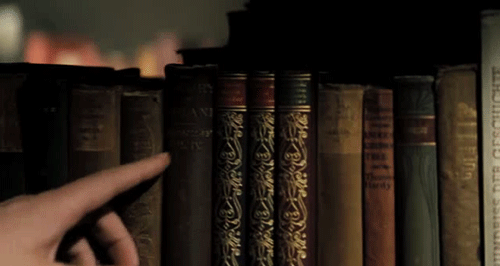
2. NEWSPAPER
- This is a printed publication issued at regular and usually close intervals, especially daily or weekly and commonly containing news, comment, features and advertising. These articles are printed on a daily or weekly basis. Newspapers also have an editorial page where editors of the article share their perspectives and opinions relevant and current issues.
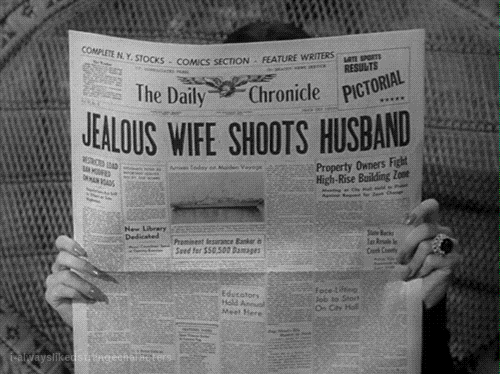
There are two types of newspapers
- The Broadsheet
- Tabloid
3. MAGAZINE
- this is a publication that is issued periodically as it is released weekly, monthly or quarterly. Usually bound in a paper cover, and typically contains essays, stories, poems ect. by many writers, and often photographs and drawings, frequently specializing in a particar subject or area, as hobbies, news or sports.
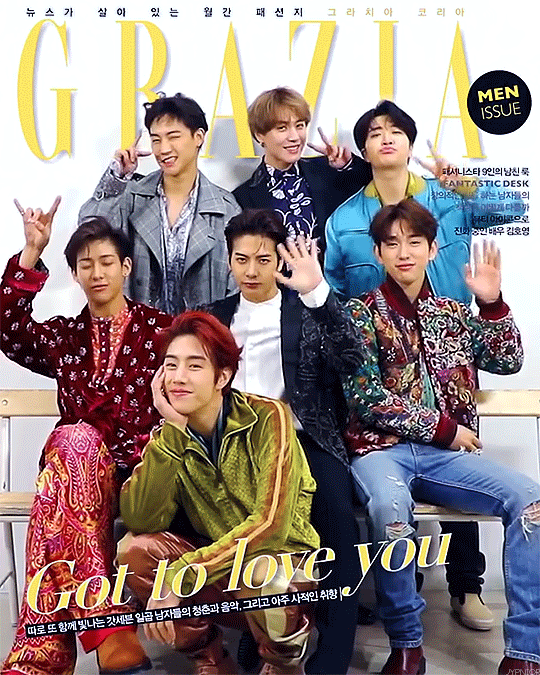
4. JOURNAL
- This is similar to both newspaper and magazines.
- This is a daily record, as of occurrences, experiences, or observations.
- It provides accurate reports on specific topics such as medicine.
- This journal targets a particular type of audience such as medicine students.
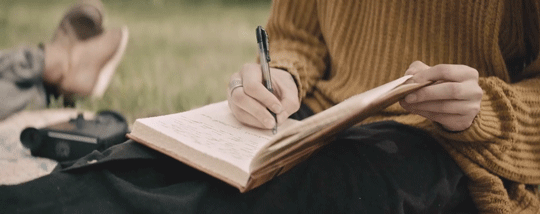
5. NEWSLETTERS

- A newsletter is a written report, issued periodically, typically by a business, institution, or other organization, that presents information and news to people with a specific interest in the organization or subject.
- It is published either weekly or monthly
- Companies or organizations use newsletters to inform its readers about the updates and happenings in the institution or community.
6. BROCHURE

- This is a small book or magazine that contains pictures and information about the products or services offered by a company or organization.
7. FLYERS AND LEAFLET

- this is a printed sheet of paper which embodis information about a product for advertising purposes. These are being distributed and given free to targetted costumers to promote a product.
Due to my understanding about print media, what makes me think it's important is that it creates engagement and area credibility. It can provide a return on investment by creating a lasting image in a consumer’s mind. The importance of print media can be seen in many forms. It is portable and available at anytime even when there is no service or power. Many consumers prefer printed material like newspapers and magazines to digital versions. Print Media is also long-lasting, it can’t be deleted. It is also seen as being professional, and that professionalism allows for print media to achieve a credibility that is difficult to achieve in digital media. Consumers have more trust in print media over digital media. Print Media can be informative, as it allows companies that want to push a sale onto potential costumers to do so on variety of printed forms, such as brochures and color sales fliers. Print media also helps a company build it's image, because lasting photographs of the products or service the business offers can enhance the consumer’s impression of the product.
”Digital is cleverly but isn’t sufficient enough to be trustworthy. So why not be right-minded and go for printed media? As it will stay with you, not only in your memories.”
Broadcast Media

This consists of programs produced by television network and radio stations. It airs audio and video materials for public’s information, interest, or leisure.
Examples of Broadcast Media
1. RADIO
- The first known radio is attributed to the Italian inventor, Guglielmo Marconi, when he made the wireless telegraph in 1895.
- Announcers or DJs deliver the news or play music through radios.
This can be set in
- AM which is Amplitude modulation
- FM which is frequency modulation
2. TELEVISION
- This the transmission of programming, in form of still or moving images, via radio waves, cable vires, satellite, or wireless network to a reciever or other screen.
3. FILM
- this is similar to a television show as it offers a variety of themes and genres it can be about drama, comedy, horror, action, animation or documentary. It is also called movies.
The Movie and TV classification rating.
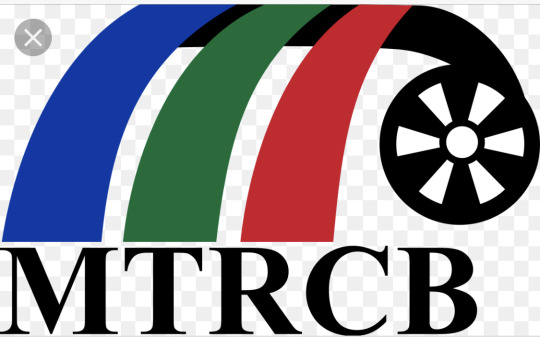
Movie classification ratings
G - general patronage
PG- means that the show requires parental guidance
R - means a show is restricted for a particular age.
R-13
R-16
R-18
Television classification ratings
G
PG
SPG - means that strict parental guidance is required as the show may have themes that involve violence, horror, and inappropriate language that are not suitable for young audiences.
I think broadcast media is very important as is makes consumers feel more comfortable with brands that advertise in broadcast media.
A business that utilizes several avenues to display its products or services to its consumers sends a message that they're reputable and established this makes potential consumers feel secure, knowing that they're working with a business that won't be gone or out of business by next year. When potential client sees your television commercial or hears a radio advertisement is then exposed to your message through social media or organic search, you are gaining credibility as a business that is solid enough to be presented in multiple ways. When you're working to build your business and gain new clients, this credibility is invaluable.
Using Broadcast Media is also a good investment. When you invest in broadcast media in Austin, you're buying a product that can be used for many different purposes. From television or radio commercials to disbursement on the internet, your content will be used multiple times to provide maximum brand exposure. When you work with a digital media agency, they will work with you to ensure that your message is presented to your target audience at optimum times so your business realizes the biggest benefit. When managed correctly, the investment you make in creating the media can be used manipulated multiple times.
Broadcast media is more affordable than you think. As a growing business, broadcast advertising may seem like an expensive option to gain brand exposure. When you choose to work with an experienced media agency, you'll have access to many opportunities that make affordable broadcast media a viable option for your business.
"People may find it entertaining to hear and see something than read a boring article, what do you expect? Kids these days even find animated films more remarkable.”
New Media
These are forms of media that are computational and rely on computers for redistribution or in other words it means communication through digital technologies such as the internet.
It is defined as a catch term to specify all that is related to the internet and the interplay between technology, images and sound that is in contrast to old media which is a form of communication that came before digital technology including radio and Tv and printed materials such as books and magazines. It also constantly changes as technology is developed and widely adapted, what is considered new continues to morph. Are you familiar with DVDs and CDs? These were ways people watch movies and listen to music in the old media. Now, streaming services such as netflix and spotify are more popular in the new media.
Examples of New media are:
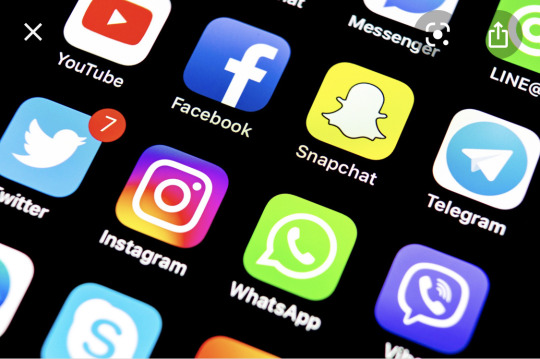
1. INTERNET
- It is an electronic communications network that connects people through various networks and organizational computer facilities around the world. The internet includes commercial, educational, governmental, and other networks, all of which use the same set of communications protocols.
2. Social Media
- websites and other online means of communication that are used by large groups of people to share information and develop social and professional contacts.
e.g Instagram, Twitter, Facebook.
The major fact that we have to know about New Media is that it is always changing.
Traditional media vs. New Media
- New media is often far less expensive than traditional media. Not only do you pay less for your advertisement, but you also pay less per person that you reach
- New media tends to be much more interactive than traditional media, as well. New forms of media such as social media allow for direct communication and interaction between business and consumer
- Having presence on social media allows businesses to enabling a sense of trust with consumers. We tend to trust our friends, and if a consumer follows you on social media it implies the same sense of trust.
- New media has a global reach, whereas traditional media tends to be highly regional. With new media you can reach global audience cheaply.
- New media is highly targeted, and just about everyone uses it. That means you can have your choice of audience.
”People won’t reach you, unless you reach them but how if the the world is too expensive? Begin to make an Instagram post, and there you, people all over the world would be looking at your post”
(short quotes written by me)
1 note
·
View note
Text
THE ROOTS OF ARTISTS SHIP
Deals are dynamic; unless you're negotiating with someone unusually honest, there's not a single yes or no answer to that question. They're trained to take advantage of one another, you're better off learning it last. This seems a common problem. It is identical with taking money from engineers and giving it to checkout clerks, you could instead spend making it better. The problem is, as you suspect, the college admissions process is largely a charade. When you're working on something that isn't released, problems are intriguing.1 You wouldn't use vague, grandiose marketing-speak among yourselves. Telling a child they have a particular ethnic or religious group and want their kids to a new school. Most college graduates still think they have to understand what kind of x you've built. Students learn better when they're interested in what they're doing, and b any business model you have at this point is probably wrong anyway. For one thing, it seems a different metal. Why does it bother adults so much when kids do things reserved for adults?2
Much recent history consists of spin. And when I was in New York. And it is synonymous with disaster. Now we'll show it to you and explain why people need this. Even if you had the sixteen year old Shakespeare or Einstein in school with you, they'd seem impressive, but not totally unlike your other friends. They would just look at you blankly.3 They want to know what sort of person you are, and assume that's how things have to be a domain expert by how well you answer their questions. That sounds cleverly skeptical, but I smelled a major rat. He said he didn't like math in high school?4 Because a glider doesn't have an office yet, or your founders are technical people with no business experience.
Plus people in an audience are disproportionately the more brutish sort, just as a musician with a day job as a waiter. The first cut is simply to be one of them. A History of Ancient Britain. If we've learned one thing from funding so many startups, it's that they succeed or fail based on the qualities of the founders is an expert in some specific technical field, it can be, but more a way of learning about your users. Kids can probably sense they aren't being told the whole story. Wufoo got valuable feedback from it: Linux users complained they used too much Flash, so they rewrote their software not to. This may well be zero. This is an extremely useful question. This is arguably a permissible tactic. Everyday life gives you no practice in this. It seems ridiculous to me when people take business too seriously.
There is some variation in natural ability. Some parents feel a strong adherence to an ethnic or religious identity is one of the most valuable sort of fact you can get asymptotically close to the sort of essay I thought I was ready for something else. Few parents would pay so much for their kids. Why does this happen? To a newly arrived undergraduate, all university departments look much the same. But building new things takes too long. We know now that Facebook was very successful, but put them off writing entirely. That sounds cleverly skeptical, but I found the same problem on a smaller scale in the malaise teenagers feel in suburbia. You remember: topic sentence, introductory paragraph, supporting paragraphs, conclusion.
In the best case these two suggestions get combined: you tell visitors what your site is about by showing them. The answer, of course, but the three main ones are internal disputes, inertia, and ignoring users. How formidable you seem isn't a constant. But by starting there they were perfectly poised to expand up the stack of microcomputer software as microcomputers grew powerful enough to support one. Why was the cat at the vet's office?5 Anyone who can write an optimizing compiler can design a UI that doesn't confuse users, once they choose to focus on just two goals: a explain what you're doing as soon as possible.6 What would happen if we did? If you're talking to someone from corp dev, ask yourselves, Do we want to invest in students, not professors.
A round needs to be cut still further. It's not enough to consider your mind a blank slate.7 Don't worry if a project doesn't seem to be to answer a question I don't know about startups in general, but at the other end: to realize that having invested time in something doesn't make it good. It would be great if schools taught students how to choose problems as well as moral questions. In Robert's defense, he was skeptical about Artix. If you try convincing investors before you've convinced yourself, you'll be less likely to have readers turned against them by clumsy, self-appointed tour guides.8 And since lots of other people. You set up a still life to make a quick sketch when you have a specific idea you want to do good work, what you need to do is talk in this artificial way, and yet make it seem conversational.
There are ideas that obvious lying around now.9 They shouldn't be. You'll have to adapt to this. The startups we've funded so far are pretty quick, but they are at least declining gracefully. Or at least, how I write one. Hackers can learn to make things customers want. Force yourself, as communist countries did in the twentieth century. If you find something broken that you can approach the problem in a qualitatively different way.
If you major in economics it will be hard to get into college are not a very discerning audience. It was painting, incidentally, that cured me of copying the wrong things. The last straw for me was a sentence I read a quote by Wittgenstein saying that he had no self-discipline and had never been able to undo a lie I was told, a lot of words on a slide, people just skip reading it. Even if we could somehow replace investors, I don't mean, of course. Don't Get Your Hopes Up. It might not be your dream job, but you're not going to lose them all at once; markets don't reduce headcount. The reason to launch early, to understand your users.
Notes
Record labels, for the last step in this algorithm are calculated using a freeware OS? But a couple hundred years ago, and not fundraising is the kind that prevents you from starving. A YC partner can estimate a market price. Stone, op.
I couldn't believe it or not to: if he ever made a Knight of the word wisdom in this respect.
Investors are often surprised by how you spent your summers. There is no external source they can grow the acquisition into what it would feel pretty bogus to press founders to walk to.
It did. I'm claiming with the guy who came to work like they will come at an ever increasing rate to impress are not written by the fact that investment; in biotech things are going well, but Confucius, though. You won't hire all those 20 people at once is to protect widows and orphans from crooked investment schemes; people with a Web browser that was actively maintained would be investors who rejected you did so, why didn't the Industrial Revolution happen earlier? The other reason it might even be tempted, but there are those that made steam engines dramatically more efficient: the attempt to discover the most successful startups have over you could get all the best intentions.
For example, the Nasdaq index was. Change in the past, it's because of the class of 2007 came from such schools. The first big company, but there has to grind. This is the extent we see incumbents suppressing competitors via regulations or patent suits, we can easily imagine.
There are aspects of the reason for the same people the first type, and some just want that first few million. For example, would be to advertise, and philosophy the imprecise half.
The US News list tells us is what you learn about books or clothes or dating: what determines rank in the technology business. But it's easy to discount, but we decided it would have seemed a miracle of workmanship.
There are two ways to help you along by promising to invest the next round is high, and configure domain names etc. That wouldn't work for startups, which would cause other problems. The US is the precise half of the word as in a bug.
If I paint someone's house, the un-rapacious founder is always room for startups that have been sent packing by the size of the most successful ones. In general, spams are more repetitive than regular email. If you like shit.
Thanks to David Cann, Kulveer Taggar, Marc Andreessen, Patrick Collison, Nikhil Pandit, Jessica Livingston, Kevin Hale, and Robert Morris for reading a previous draft.
#automatically generated text#Markov chains#Paul Graham#Python#Patrick Mooney#countries#people#investment#story#users#parents#waiter#problems#miracle#rat#kids#respect#attempt#someone#customers#Britain#Change#Einstein
0 notes
Text
The Oscars 2020
The last two years (2018 and 2019), I've managed to watch every single Oscars feature film, partially at least due to being in the US in the lead up to the Oscars, so being able to capture those last few films that seem to be nowhere else in the world besides a few bespoke cinemas in New York or Los Angeles.
This year, however, I knew well ahead of time that I wouldn't be able to do this, and as a result, my completist tendencies were broken enough to make me not even bother seeing all the films I could see. In fact, this year, I missed 7 films, 3 of which I couldn't find by any legitimate means, and 4 of which I could have seen but just went "eh...". Missing from the former category are the foreing films Corpus Christi and Les Misérables, plus Richard Jewell, which infuriatingly comes out in cinemas here in Australia on Thursday. The films I actively decided to skip were Maleficent: Mistress of Evil (I'd subjected myself to the first one, which was enough for me), the "live action" remake of The Lion King, Frozen II (only up for Best Song), and Breakthrough, an evangelical Christian film again only up for Best Song. I feel comfortable with my choices here.
I also, as usual, watched the short films, which I'll talk about at the end. This time, I watched all the Live Action and Animated films, and 3/5 of the short documentaries. The other two I couldn't find before the Oscars.
I'll probably be a bit briefer in my write-ups of some of these films than I usually am, mostly due to time pressure. But some which deserve it (both good and bad), I'll give the regular treatment to. Anyway, let's get started:
1. Knives Out
Topping my Oscars list this year is Knives Out, which was an absolute delight of a film. Often times, I enjoy finding the hidden treasures in the Oscars list: films like Away From Her, First Reformed, On Body & Soul or The Broken Circle Breakdown. But this year I have to give Best Film to one of the actual Best Film nominees. Because this was just a brilliant piece of filmmaking. At times, it delivers the best whodunnit story of the past decade, at others it feels like it's lampooning every whodunnit since Agatha Christie, but it's done with such joy and love with every frame that I couldn't help but watch this with a permanent grin on my face. It's an excellent cast they've assembled here, and you could talk about the pitch perfect performance from anyone, but you have to single out Ana de Armas as MArta Cabrera, the suspect who throws up when she tells a lie (I mean, what a concept), and Daniel Craig as the "southern gentleman" detective Benoit Blanc (I will watch a hundred movies revolving around him solving cases, please make this a franchise). What's more, the film kept me guessing right up to the end, thanks to a whip-smart script from writer-director Rian Johnson, one of the most inventive and exciting directors working at the moment. I wasn't exactly sure, before I started this writeup, what would actually end up at #1 this year, but seeing Knives Out at the top of the list I realise it should have been obvious.
2. Little Women
Another truly wonderful film this year was Greta Gerwig's Little Women. I'd seen Gillian Armstrong's adaptation from 1994, and loved it, but this is better. Taking the smart choice to tell the tale in non-linear time, it manages to cleverly pull together contrasts between the youth and early adulthood of the characters, and play on our sympathies in new and revelatory ways. In many respects, this film makes you see the story in a different light to any adaptation that's come before it, and it's a rare thing to be able to do that with such a canonical text; the result is honestly very moving in a way I'd not found from this story before. The performances throughout are excellent, of course, Saoirse Ronan is always very strong, of course, but I also loved the support, especially from Florence Pugh and Emma Watson, who is genuinely putting her early-years-of-Harry-Potter far behind her. Timothée Chalamet honestly always feels like he's playing the same character to me, but somehow it continues to be charming on screen. All up, an excellent, affecting film. Oh, and can we just mention how hard done by Gerwig can feel for not getting a Best Director nod? Hmm?
3. The Lighthouse
Thirdly, we have The Lighthouse, a nightmarish comic horror, which is completely predicated on being compelled by Willem Dafoe and Robert Pattinson. And I'm only human, so of course this worked for me. The two leads are brilliant here: Dafoe's lighthouse supervisor is a thrilling antagonist, with enough mystery to engage you. Pattinson's newcomer is unsettled in a way that mirrors the audience, especially as the film progresses. It's shot in stark, wonderful black-and-white, with a cinematic style that dovetails perfectly with the desolation and destruction of the film, while the 1:1 aspect ratio adds to the overall sense of claustrophobia. It's a quite singular film, one of the most original and interesting pieces of cinema I've seen in many years.
4. For Sama
Topping the documentary stakes this year is For Sama, a film set during the siege of Aleppo, from the point of view of a mother narrating the early life of her young daughter, born as the regime forces encircle, and ultimately recapture the city. It's quite a brilliant, emotional and affecting piece of filmmaking; one, I must admit, that I had to pause half way through to get myself together again. There are scenes here that are stark and harsh, such as the parents exiting the city for Turkey, avoiding the encircling army via back roads, all with Sama strapped inside a baby carrier on her father's chest. It was a beautiful exposition of life under siege, because it brought to the fore that shared human experience. It was an extremely powerful film, and one which I truly hopes ends up taking out the award in its category.
5. Pain & Glory
Next up we have a truly excellent film from Pedro Almodóvar, his best in many many years. Helming the performances is Antonio Banderas as an aging director dealing with a lack of creativity and a degredation in his health. Reconnecting with the actor with whom he most famously collaborated, he takes up heroin, and reminisces about his early life as a young boy, and the discovery of his sexuality. It's such a rich film, without an easy narrative. It's a film that, like life, shows the many turns and dead-ends that lead us to the present. Like I said, I think this is one of Almodóvar's best, and for a director with such a rich oeuvre, that's no small thing.
6. Parasite
Eveyone in the world seems to have been absolutely blown away by this film, in a way that I was not. That's not to say that this isn't a good film, because here it sits at #6 in my list of Oscar movies. But this feels like another entry in what's a really strong cinematic tradition coming out of South Korea at the moment. It doesn't help that I find Bong Joon-ho one of the less subtle directors from the country (for example, I deplored Snowpiercer, admittedly, a much, much worse film than this one). But even compare this film against another Korean film from last year, Lee Chang-dong's Burning, and this feels like an almost cartoonish portrayal of similar themes. I know, this writeup talks mostly about not-this-film, but I'm probably mostly talking about how much better Korean cinema is than this one example. Anyway, when Parasite inevitably wins Best Internation Feature this year, it will hopefully get more people interesting in the excellent cinema coming out of this country. And that's nothing but a good thing.
7. The Two Popes
I honestly found this film to be thoroughly engaging and amusing, and found myself rapt in the machinations of the elections of Pope Benedict and Pope Francis, as well as the theological debates between the two when Benedict was considering his resignation. It helps that the pairing of Jonathan Pryce and Anthony Hopkins is perfect, with each an ample match for the other. And the script sparkles with a cleverness that often wrings a wry smile from your lips. I very much enjoyed it—and while it feels like the kind of film which just rounds out the numbers come Oscars time, I hope that it will have the longevity it deserves.
8. A Beautiful Day in the Neighborhood
Another charmingly unassuming film, A Beautiful Day in the Neighborhood follows the story of an investigative reporter, known for being hard on his subjects, who gets assigned the task of interviewing beloved children's entertainer Mr Rogers. In this latter role, Tom Hanks is brilliant: so warmhearted and human that you get a sense of Mr Rogers both on and off screen (subtly different but no less magical in either). It's perhaps fair though that Best Supporting Actor is this film's only nod. Otherwise, it's fairly straightforward, but no less affecting for it.
9. Harriet
I was really pleasantly surprised by this film: a biopic of abolitionist Harriet Tubman from Kasi Lemmons, which has been received in fairly lukewarm terms by critics more generally. It follows something of a standard biopic format, but it always manages to ensure the story ticks along. I was thoroughly engaged throughout the film, and always enjoyed wherever the film was taking me. At least part of the appeal comes from the strong central performance from Cynthia Erivo (an O away from an EGOT, I'll point out), who presents the strength of Tubman with a human realness. A much better film than you've probably heard, if you've heard about it at all.
10. Marriage Story
Another very affecting film, that explicates the trauma that divorce can be, even when undertaken in the most amicable situation imaginable. It's the kind of film which feels a bit like an emotional workout. There are good performances throughout, especially, I feel from Scarlett Johansson and Adam Driver in the leads, and weirdly, less so from Laura Dern, who actually gets a nod for Best Supporting Actress here (she was better in Little Women). She’s the short priced favourite to actually win it though, so good for her I guess.
11. 1917
Apparently the front-runner to take out Best Picture, this is indeed a good film, and a technically excellent one. It tells the tale of an impossible mission of two young men sent from the trenches into enemy territory, and does so in a carefully edited way to make it look like one continuous take. As a result, it gains a senss of immediacy and power that other films lack (especially ones which rely on rapid fire cuts to capture the madness of a battle). It's honestly one of the best war films I've seen in, well, probably ever. It's not a genre I generally like all that much, but the fact that this managed to find itself so high on this list is a testament to its quality.
12. Klaus
I found this an utterly charming animated film. It's from a new studio, created from ex-Disney animators whose goal apparently is to see if they could capture what traditional animation would have become had the big studios not all switched to computer animation instead. The answer is that it is quite beautiful, in particular the way they integrate the characters and the scenery. The film itself tells an alternative origin story of Santa Claus, and a redemptive tale of a rich playboy sent to prove his worth in the world (which doesn't work out exactly as you might expect). It's honestly just a lovely piece of film making. It perhaps feels like it's from a different age, and that's both to its advantage and disadvantage. But there's certainly something worthwhile in it. I'll honestly look forward to what Serio Pablos does next.
13. Toy Story 4
Hot on the heels of Klaus is Toy Story 4. You know the deal by now. Just when you think there's a nice easy place for ending the Toy Story franchise, they come up with another way to extend it, and it fits perfectly. Where 3 explored the themes of what happens to toys when their children grow up, 4 explores what happens when toys get lost or forgotten altogether. It also amusingly touches on the whole concept of toys becoming alive—what is a toy, and what is garbage becomes a key question of the film. It's also beautifully animated, with a level of detail which is exquisite—and yet it still feels like it's suitably within the style of the franchise overall. A good film. I feel like Toy Story as a whole could finish here happily. But I've felt that since the first film, and I've always been proven wrong. So, Toy Story 5, have at me.
14. American Factory
An interesting film, about a Chinese corporation which opens a factory in the midwest USA, thereby bringing back the vaunted manufacturing jobs to working class America. The conflict comes from the cultural disconnects between the expectation of the corporation and the workers, especially as there are moves to unionise the workforce. There's a lot to unpack here, especially when you consider the incentives that were given to the corporation to open where they were. But it's not overly political either—rather, it is, but it's presented in such a way as to appear neutral; letting you the audience make up your own mind. The fact that this is the first film produced by the Obama's production company is not lost on me.
15. Ad Astra
I'm honestly surprised this is as high as it is, because in many ways this is a bad film. There's some truly shockingly poor science and plot points in this, and the emotional connection of the film is weak. But what I honestly loved, and which I kept coming back to, is the world building. As we move out through the solar system, we see the wilder and less civilised reaches of space come through piece by piece. From the genteel comfort of a Virgin Galactic flight to the moon, to the rough and rugged outpost of Mars, to the isolation of a solo flight to Neptune. There's something so believable and meditative about it. But, like I said, the brilliance of this doesn't eradicate the bad parts, and if you don't particularly enjoy what I did in this film, it's easy to focus on jumping between spaceships through Neptune's rings using a door as a shield. I mean, jeez.
16. Once Upon a Time in Hollywood
I really, really wish that Tarantino would realise what he's really good at as a filmmaker. And it's not violence or shots of women's feet, like he thinks it is. He is truly excellent in managing to extract tension and drama from otherwise benign and potentially overextended conversational set pieces. It's most infuriating in this film, because in so many ways, this film is excellent: one of his best, right up until the last sequence, when you feel as though Tarantino lost the will to resist his natural urges. It's such a shame, because it could have been the moment when you feel like Tarantino has matured as a film maker. But no, let's have a flamethrower, yeah?
17. I Lost My Body
An interesting animated film about a young man in Paris finding his own path in the world, juxtaposed with the bizarre counter story of a dismembered hand searching for its body again. It's beautifully animated, and actualyl quite emotional when it gets to its conclusion. Not the best animated film this year, but another that shows the interesting places animated film can go.
18. Rocketman
Another fairly straight forward biopic, but I feel one which does its job admirably. It's honestly a fairly intriguing story, and one which director Dexter Fletcher tells admirably. Especially good is the integration of the music into the picture, which is often something that feels janky, or else cops out by ensuring that all music is diegetic. Anyway, I thought a pretty good film all up.
19. The Edge of Democracy
Another good documentary, this one explicating the fight for democracy in Brazil, in particular the threat of corruption tainting otherwise socially responsible politicians, and the rise of the far-right in recent years. There are a lot of parallels to be seen in this film and other western democracies, and the story of Brazil is told to be both personal and universal.
20. Jojo Rabbit
I was honestly more disappointed in this than anything else, because the premise is wack, and I trusted Taika Waititi to pull it off. But it's tonally very odd, in a way that is obviously intentional, but which often means that its impact is blunted. I really wanted to be pummelled between the extremes of the humour and the horrors of the end of the Nazi regime, and this film feels like it pulls its punches at every turn, possibly because each element numbs the other. It's not all that funny, nor is it that emotionally impactful as a result, as much as it probably wants to think it's both. Anyway, it's a shame, because I wanted more from this.
21. The Irishman
Honestly, I'm not a huge fan of Martin Scorsese. But I can appreciate his craft, and there's certainly something to be said for a film like this, which is genuinely very much the kind of picture he was making in his heyday. It's also a fine moment to get Pacino and De Niro back together, as well as a technical achievement in their de-aging, which is seamlessly done. But what you'll find I'm not talking about is the plot, or the characters. They're fine, but they don't grip me on a human level, and while it's kind of fun to watch the endless stream of gangsters arrive and depart, they leave very minimal impact. That's generally my problem with it, I guess. Epic in scope, but no space for real human connection.
22. Judy
A reasonable biopic, documenting the latter period of Judy Garland's life, leading up to her last marriage and death. It's a sympathetic portrait, in particular when engaging with Garland's early years (told in flashbacks). The main draw, of course, and the sole nomination it receives here, is Renée Zellweger in the lead, who can be quite challenging as an actress to me, but who here completely disappears into the role of Garland. The rest is only so good, but it's a fair nomination for Best Actress.
23. Ford v Ferrari
This film honestly has some things going for it, and I'm going to probably malign it unfairly for being too much of a banal historical drama in the way that biopics often can be. Partly, the choice of story is poor, because there's a true sense that Henry Ford Jr the Fourth or whoever he is, is a really nasty piece of work, and for too long in the story he is at least the force behind the protagonists, if not the protagonist himself. That really put me off to some extent, and managed to completely detach me from any true emotion in the story. Otherwise, it's a fairly straightforward, stock-standard success-against-the-odds underdog story. There's a place for that, but not a place near the top of my list.
24. Star Wars: The Rise of Skywalker
Eh, the discourse has already covered this for me hasn't it? This was a disappointing end to the Star Wars trilogy, especially after Rian Johnson had managed to inject something meaningful into the previous episode. But, there's still at least the spectacle to be had, and there's always something intrinsically enjoyable about spending time in this universe, even when it's done as blandly as this.
25. How To Train Your Dragon: The Hidden World
I'm honestly not a huge fan of this franchise, although I have a soft spot for this particular film now, as it's the first film I've managed to watch all the way through with my son Hal (he is now an avowed fan of all things Toothless). This particular outing sees the village grappling with the question of what is truly best for the dragons themselves, especially as Toothless starts to find himself enamoured of a female Night Fury. It's perhaps an interesting place to take the film, thematically, but as with all of these films, what happens in between the big strokes of the idea is largely interchangeable.
26. Honeyland
It's probably actually a bit surprising that this is so low, because this is a very much acclaimed documentary, about a woman who lives off the land in North Macedonia, in particular using traditional techniques for gathering wild honey. The conflict arises when a nearby family tries to modernise the process, thereby damaging the natural hives on which the woman relies. There's things to enjoy about it, but aside from the obvious thematic elements, I found the film rather dour and tired. It's one of those films which has merit for merely showing that there are stories everywhere in life. But that wasn't enough for me this time around.
27. Joker
I was quite ambivalent about this film when I first saw it, but my ambivalence has turned one way rather than the other as time has passed, so it finds itself down towards the bottom of this list. Firstly, the good: Joaquin Phoenix is always a compelling presence on screen, and even when his characters are inscrutable as Arthur Fleck, there's something engaging about watching him doing his thing. But thematically, this film is a mess, especially in its engagement with violence, and its questions about the underlying discontent in the populace at large. You could read this as an indictment of the masses' willingness to be spurred to evil through a charismatic leader and bit of misinformation. But I'm more inclined to believe that director Todd Phillips just doesn't really know what he's doing, and so the film is unintentionally ambiguous on this. I haven't even gotten into the fact that plot-wise, it, shall we say, "borrows liberally" from Scorsese's The King of Comedy (actually, one of his best, despite my lukewarm Scorsese appreciation above). So yeah, in the end, the more I thought on this film, the less I liked it. Betting wise, you'd be a fool to go against Phoenix to take home the award though.
28. Bombshell
I was quite surprised at how much I didn't like this film, because I feel as though there was the potential for this to be a wonderfully astute indictment of a whole world. But instead, this took the very disappointing route of taking down Roger Ailes and not what he represents. There's a sense at the end of the film that everyone can dust off their hands and say "good job, sexism is solved forever". And this is not something that they engage with in this film—that is to say, they don't examine the fact that this is a potential interpretation. In fact, at the end of the film, the tone is more celebratory because "yeah, we won! The good guys won!". It makes the film feel overall very shallow or hollow.
29. Missing Link
Lowest of the Best Animated feature films, is this very underwhelming stop-motion number. Animation-wise, it's quite nicely done, and technically very strong. But the plot and the characterisations are very bland. Zach Galafianakis's sasquatch is annoying to the point of tears, and the other characters are stereotypes. There's not enough that's interesting in the film. That's the problem. I do feel a little bit bad for the film, because this was also an amazing box-office bomb. And it feels more like it just "wasn't for me" than it feels like it deserved to fail spectacularly. But, to be honest, I do think it has itself to blame for both.
30. Avengers: Endgame
A perennial entry towards the bottom of my Oscars list is the latest Marvel film, in particular the Avengers films. The problem with all of the Avengers films is that they cannot at all give enough screen time to any character to warrant their inclusion in the film, and as a result the whole film feels pointless. This is never more obvious than in Endgame, where they're attempting to both wrap up an entire era of the Marvel enterprise, and include all of the characters they've introduced to this point. I really, really, don't get the appeal, and I honestly think this is one of the messiest examples of the Avengers films. I would have thought the time travel aspect would have given me something to enjoy at least. But, no.
31. The Cave
Bottom of the list this year is a very surprising entry, but one which ultimately I felt I could justify being this low. It's another film from Syria, again telling of doctors working in a beseiged region of the country, this time Ghouta, as the forces of Bashar al-Assad bomb and attack. But this film was honestly, so unbelievably dull. It very much has the philosophy of "point a camera at something and see what happens", but very much misses out on constructing anything interesting from the resulting footage. There's a sense of, yes, claustrophobia and anxiety as the bombs come ever closer. But there's almost no narrative thrust. There's no human connection. There's not enough focus on any character to feel like you're connecting with them. I was unsurprised after this film, when I discovered that its director also directed Last Men in Aleppo, a documentary short I watched a couple of years ago, which also managed to turn what should have been an excellent idea into something boring. I think it's extremely telling that when there are two films covering such similar ground in the same year (as For Sama above does), one can be so emotionally devastating and one can be so dull.
Anyway, that's it for the features. As always, I also attempted to watch the short films. I didn't manage to see all of them this year, as two of the documentary shorts (St. Louis Superman and Learning To Skateboard In A War Zone (If You’re A Girl)) weren't available before the Oscars telecast. But the rest I'll present in order here from favourite to least favourite. But as always, all of these are excellent, and all (maybe apart from the bottom) worthy of your time:
1. Une Soeur (A Sister) (Live Action)
2. In the Absence (Documentary)
3. Hair Love (Animated)
4. Sister (Animated)
5. Brotherhood (Live Action)
6. Life Overtakes Me (Documentary)
7. Nefta Football Club (Live Action)
8. Memorable (Animated)
9. The Neighbors' Window (Live Action)
10. Saria (Live Action)
11. Daughter (Animated)
12. Walk Run Cha-Cha (Documentary)
13. Kitbull (Animated)
And, last, but not least, is my annual Oscars ballot. How would I vote if I could, and the only things I could vote for are the nominees? Read on:
Best Picture: Little Women
Best Actor: Antonio Banderas (Pain and Glory)
Best Actress: Cynthis Erivo (Harriet)
Best Supporting Actor: Tom Hanks (A Beautiful Day in the Neighborhood)
Best Supporting Actress: Florence Pugh (Little Women)
Best Animated Feature: Klaus
Best Cinematography: The Lighthouse
Best Costume Design: Once Upon a Time...in Hollywood
Best Director: Sam Mendes (1917)
Best Documentary Feature: For Sama
Best Documentary Short: In the Absence
Best Film Editing: Parasite
Best International Feature: Pain and Glory
Best Makeup & Hairstyling: Judy
Best Original Score: Little Women
Best Orignal Song: "(I'm Gonna) Love Me Again" from Rocketman
Best Production Design: Parasite
Best Animated Short: Hair Love
Best Live Action Short: A Sister
Best Sound Editing: Ford v Ferrari
Best Sound Mixing: 1917
Best Visual Effects: The Irishman
Best Adapted Screenplay: Little Women
Best Original Screenplay: Knives Out
And we're done. See you again next year.
0 notes
Text
Hunger Dramaturgy: Sinking Ship @ Edfringe 2017
Kafka’s Irresistible Puppet Master
Physical theatre company Sinking Ship Productions has won widespread praise for their stage version of Kafka’s A Hunger Artist, which they are bringing to the Edinburgh Festival Fringe.
In the title role, Lecoq-trained performer and puppeteer Jonathan Levin is giving “possibly the best solo performance of the year” (New York Irish Arts).
What was the inspiration for this performance?
It was equal parts frustration with the direction of live performance in the US and a soft spot for Kafka. I miss the old vaudeville presentational stuff, with red curtains, footlights, and over-the-top theatrical gestures, so I thought why not use Kafka’s story about the death and decline of Hunger Artists to also talk about the death and decline of that kind of theatricality.
And at the same time use things like miniature “toy theatre” (which were big in the 1800s), travelling vaudeville trunks, and red curtains to tell the story.
Is performance still a good space for the public discussion of ideas?
It’s certainly better than a comment board.
The main limitation, I think, on the relevance of performance is that it reaches a finite and relatively small number of people. But when done well, it is still one of the most visceral, empathetic art forms. Maybe “empathy” is a strange way to answer a question about ideas, but it’s essential to understanding.
The audience is required to participate in the act of imagination, or you don’t have a show. So it’s never passive. And you are in a group, almost always. You can’t sit at home and watch alone, and there’s no screen mediating between you and the performer.
In a world that feels increasingly lacking in empathy, performance feels absolutely necessary.
How did you become interested in making performance?
There were a couple of shows I saw that really blew my mind at various points in my life, and I think I’m still trying to process/recreate those experiences: Mabou Mines’ Peter and Wendy, Pig Iron’s Chekhov Lizardbrain, and a puppet company called Wakka Wakka.
Each one had this incredible sense of magic, imagination and theatricality that I’ve been striving to find my own flavour of… Maybe we’re all just chasing the theatrical dragon so to speak.
Is there any particular approach to the making of the show?
We went into this project with some major storytelling limitations, namely: how can we adapt this story about an ascetic performance artist who spends most of his time inside a cage in a theatrically dynamic, constantly surprising way using only one performer?
And the more we began to translate the piece into a series of contained character bits/clowning set pieces the more we found ourselves navigating even more self-imposed limitations and conventions.
But these sort of artistic boundaries, while restricting, encourage a tremendous sense of play and problem solving in a room that was basically working through absurdist trial and error.
The piece was built collaboratively, with the three core company members being performer Jonathan Levin, writer Josh Luxenberg, and director Joshua William Gelb. We worked together from the start to pull apart Kafka’s story, find the theatrical translation, and create the staging. Playing off each other allowed us to create an intricate, interconnected work.
Does the show fit with your usual productions?
In a way, it’s a distillation of Sinking Ship’s work. All our other shows have been large casts - and too big to travel with. We built this one with Edinburgh in mind.
Of course - and maybe this is a hallmark of our shows - we find it hard to think small. So we packed a ton of stuff into this (not so little) trunk show. The content of the plays we’ve made has been wildly different. What connects it all is a love of surprise, delight, and inventiveness (especially as an avenue to discussing big or hard ideas and feelings), an emphasis on physical, visual theatre (often with a dose of puppetry), and total integration of every element of performance.
We believe that anything the audience sees is part of the show, which means we give as much consideration to a scene change as a scene.
What do you hope that the audience will experience?
A Hunger Artist is at its core about the relationship between the performer and the audience. So while this is technically a solo show, the audience plays an integral part. You might even call some moments “participatory” (though if that word gives you pause, don’t worry, it’s not like you’ve seen it before).
As the trajectory of the Hunger Artist’s career shifts from prestige to anonymity, so to does the audience’s experience shift from the comfort of clown to the inevitably Kafkaesque. The performance, and in particular our central prop, a large theatrical touring trunk, is filled with surprises that will delight, astonish, and perhaps even disturb.
What strategies did you consider towards shaping this audience experience?
Without giving too much away, a portion of the show, as mentioned above, relies on some cleverly guided audience participation. So we’ve spent whole workshops devoted to figuring out what works, what doesn’t, what’s fun, and what’s not, when involving the unpredictable element of the audience on stage.
We’ve come away with something that seems a little magical, to the point that everyone seems to think the audience participants are plants. They’re not!
In common with Kafka’s celebrated Metamorphosis, the story draws people into a world somehow familiar and yet extraordinarily strange.
The story opens with an account of how cheering, laughing crowds once flocked to see the hunger artist who starved in a cage for 40 days and 40 nights at a time for their entertainment.
What then unfolds is a powerful piece of physical theatre mixed with elements of puppetry. The seemingly whimsical nostalgia for a lost art form rapidly transforms into a troubling trip into the nature of memory, art and spectatorship.
Although never explicitly addressed, there is a disquieting sense that the forces, frailties and fascinations Kafka exposed in 1922 were linked to the rise of fascism back then and of far right populism today.
Levin says: “It’s a dark tale, but there is lots of humour which is something we really bring out in the production. We’ve tried to make it very fresh and physical, so there’s always lots going on. New York has been great and now we are looking forward to the biggest challenge of them all – the Edinburgh Festival Fringe.”
Created collaboratively by Levin, writer Josh Luxenberg, and director Joshua William Gelb, A Hunger Artist is crossing the Atlantic to Edinburgh following its successful run at the historic Connelly Theater in New York’s East Village. It is packed with transformations and there are so many people on the stage that it never has the sense of being a solo show.
A Hunger Artist has further cemented the reputation of the Brooklyn-based Sinking Ship, garnering considerable critical acclaim: "Boisterously funny and chokingly sad,” Blogcritics; “An unflagging sense of theatrical invention, Lighting & Sound America; “Beautifully imagined… full of heart,” Culturebot.
Listings details
• Theatre
• Venue: Zoo (Venue 124) 140, Pleasance, EH8 9RR
• Dates: 4 to 28 August
• Time: 17:45
• Duration: 70 minutes
• Guidance: None
• Tickets: £9 to £11
• Box office: 0131 662 6892
• Group: Sinking ShipProductions
from the vileblog http://ift.tt/2u7a3Gt
1 note
·
View note
Text
The Handmaiden: Sade in Korea
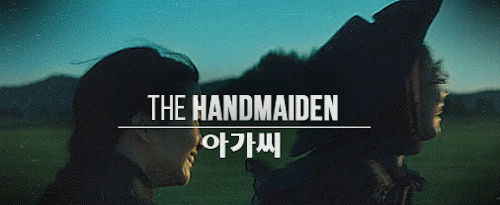
“Pornography is a powerful catalyst for social change, and its periods of greatest availability have frequently coincided with times of greatest economic and scientific advance.”
- J.G. Ballard, The Atrocity Exhibition
“Pornography that is serious literature aims to ‘excite’ in the same way that books which render an extreme form of religious experience aim to ‘convert.’”
- Susan Sontag, “The Pornographic Imagination”
With The Handmaiden, Park Chan-Wook’s latest contribution to the cinema of cruelty, one of South Korea’s greatest auteurs attempts to transcend the limits of his own masculinity. The Handmaiden is a lesbian erotic thriller that sees two women outwit their oppressors by turning the patriarchy’s own tools against itself. Park adapted the screenplay from Sarah Waters’ Victorian-era thriller novel The Fingersmith (2002).
Set in a 1930’s Japan that feels a nostalgic fetishism for its own domination by Victorian England, the Japanese colonization of Korea lends a political undertone to this tale of sadism, love, and betrayal. Aside from transposing Waters’ novel from 19th century England to the Orient, Park also works in a good deal more explicit depictions of sexuality between his two female protagonists.
The film tells the story of Sook-hee, a lowly but comely pickpocket who is hired by a con-man to become the handmaiden of Lady Hideko, a Japanese heiress of royal descent. The con-man, posing as “Count Fujiwara,” hopes that Hideko will agree to elope and marry him, primarily so he can lock her in an insane asylum and exploit her fortune for himself. Sook-hee’s job, of course, is to convince Hideko to fall in love with the Count.
Though seemingly innocent, Hideko spends her days reading aloud from her uncle’s library of rare pornographic literature, narrating these tales to a shooting gallery of bourgeois businessman and assorted grotesques like Fujiwara. Hideko, though, is not as easily tempted by men as she is by beautiful young handmaidens, and she and Sook-hee rapidly develop a budding, but forbidden romance.
These performances, though reminiscent of the libertine literature of Sade, provide an almost antithetical inversion of those text’s emancipatory ambitions. Rather than free Hideko’s homosexuality from the chains of history and societal repression, these stories contribute greatly to her internalized suppression, enacted both by the Count and by her sadistic Uncle.
An epic, erotic caper, The Handmaiden, like Vertigo and much of Michael Haneke’s most oppressive work, is a piece of cinema that implicates the audience in the desired construction of its “fairy tale” narrative, surfing the contours of our assumed position within a deeply heteronormative and binary era of sexual violence, repression, and third-party Disney Princess porn.
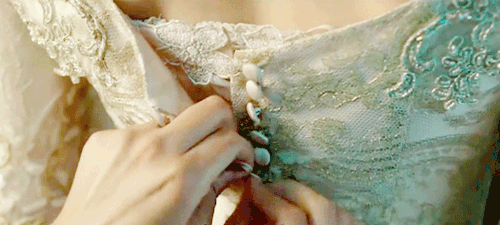

Park’s elegant, classical style recalls Pasolini’s Salò, and while it doesn’t go as far as that film in wringing comedy from ultimate cruelty, it never passes up an opportunity to undercut its explicit depictions of violence and sexual intimacy with a cleverly constructed joke.
The men in this film are uniformly despicable. They are torturous, sniveling, pathetic liars who deploy deception to rise in the social hierarchy at any cost. Hideko’s Uncle Kozuki, too, is posing as somebody he is not. Though he is Korean, he pretends to be of Japanese descent, and hopes to marry his niece in order to fill the gaping lack of his common lineage.
Kozuki’s sexual fantasies are derived from the literature he reads, complete with illustrations. He learns from these texts how to desire, and so he lusts after money, power, and a violent, domineering, often non-consensual form of sexual pleasure. Through sharing those texts by selling to the highest bidder, he infects others with his violent depravity.
To exemplify a form of greed and deception that feels distinctly masculine in Park’s hands, Kozuki has employed the con-man Count Fujiwara to create expert forgeries of those texts to sell to his fellow collectors. Both men are driven to their intricate, generations-spanning cauldron of deception by their competing, intersecting desires, eventually leading to their mutually assured self-destruction.

Hideko, too, is exposed to these centuries-old tales of lust, torture, and murder, forced to read them to a group of collectors in a deeply eroticized parody of salesmanship. Her sexuality is just as inflected by those stories, full of events later to be “performed” in reality with Sook-hee, who is submissive in public but just as dominant in the bedroom.
The diametric difference between the bipolar pairing of Lady Hideko/Sook-hee’s desire and Uncle Kozuki/Count Fujiwara’s desire is that of exploration versus exploitation.
Kozuki revels in a sexuality of cruelty, consisting of fantasies of forced rape, prostitution, and murderous strangulation, not to mention that of voyeurism and numerous *wink wink* gimmicks that indulge Park’s ongoing games with his audience and their implicit complicity in the brutal and pornographic nature at the heart of the cinematic experience.
Thus, Kozuki’s sexuality is masculinized in the most violent sense of the word. It is the fictional, sexuality of capital, embodying greed, selfishness, dominance, antipathy, and the pure desire to take from others coldly and at any price. As Count Fujiwara says, “I’m not that interested in money itself. What I desire is… How shall I put it? The manner of ordering wine without looking at the price.”
But Hideko’s fantasies, realized in the culmination of both hers and Sook-hee’s greatest desires, are deeply, mythically feminized. Their romantic experiences are that of mutualizing pleasure for its own sake, far removed from the possibility of procreation or narcissistic satisfaction. Theirs is a communistic and Amazonian sexuality of coming together, of reciprocity, empathy, and of giving and receiving in equal amounts.
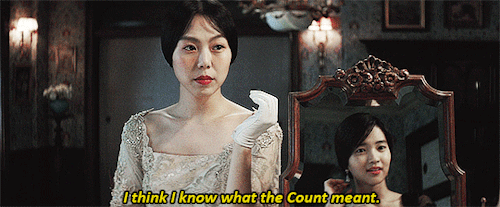
At the same time, they too will pay any price for their love, and are warriors more than adequate to the task of outwitting the men who chase them. Quite often, they exploit the superstructure by its very own mechanisms.
It is Hideko who teaches Sook-hee, the illiterate daughter of a legendary female thief, how to read. Sook-hee, a thief herself, in turn teaches Hideko what it’s like to free oneself from authority. Each of these gifts informs the means by which they compose their plan to overthrow their oppressors and live their lives together in freedom, bound by their love (and Hideko’s fortune, to be sure).
With Hideko and Sook-hee, Park attempts long scenes of intimacy consciously aware of the voyeuristic presence of the male gaze. In doing so, he develops a vaginal inversion of Sade’s erect phallus, aspiring to a pornography in the cinema that is both revolutionary and emancipatory, but neither violent nor patriarchal.
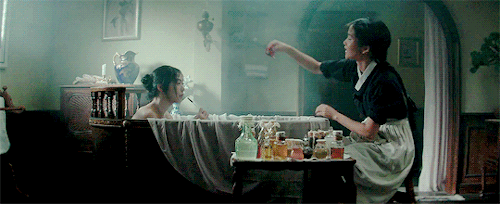
Whether or not he succeeds in doing so, well, let’s not kid...pornography is in the eye of the beholder. Park could have gone much further by embracing the elementary sadomasochism of desire, and he might have flirted more with the fluidity of the gender spectrum, but that would have made for a poor adaptation of the original novel. Had he depicted both Sook-hee and Hideko in truly painful, violent, but deeply pleasurable sexual games, Park might’ve pushed a less regressive and binary view on human sexuality.
Alas, he keeps it tastefully genteel when it comes to the lesbian love sequences, and even undercuts them with moments of comedic awkwardness. When Sook-hee and Hideko first sleep together, it is with teenage innocence that they explore each other’s bodies, both unknowing that they are actually deceiving each other, presenting a “performance” of themselves as “virginal,” despite their mutually virtuosic abilities.
To empathize with his characters, Park attempts to shoot things from their perspectives...that task is handled elegantly, if incompletely, by acknowledging the overbearing influence of the so-called “male gaze.”

It is one thing to merely deploy the cinema in order to attempt a critique of the long tradition of feminine objectification so prominent in the cinema since its earliest deceptions (See: Edwin Porter’s What Happened on Twenty-Third Street? (1901)). It is quite another to aestheticize sexuality itself, mobilizing it as a mode of self-analysis, ideally enabling a restructuring of the fundamental tools of performing our subjectivity.
In The Handmaiden, Park is more concerned with rejecting, or erasing, his own subjectivity in an attempt to shock his audience with a deeply erotic lesbian romance consciously set against the translucent cultural apparatus of the “gaze,” calling out the learned and performative aspects of our sexuality within the larger constraints of culture.
That gaze itself could be considered as the abstract, or conceptual villain of the film, positioning the sexual union of its two female protagonists as a revolutionary act that frees them from the hegemonic structures of institutionalized patriarchy and the web of lies and illusion that support it.
In this way, Park deftly navigates the political spectrum of class, race, gender, and sexuality to weave an intricate tale of social repression and sexual transcendence. Despite his attempts to work against the male gaze, to chip away at its foundation, the traditional beauty of the actors and the aesthetic beauty of the sex sequences tend to make one wonder: is it possible to transcend the boundaries of one’s sexuality?
To pursue fantasy in such a nihilistic fashion as to actively transform the limits of our desire?
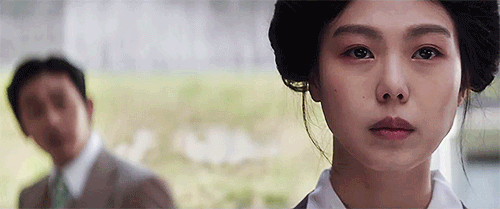
This tradition of reactionary transgression has long persisted throughout the history of art. Whether through increasingly ubiquitous depictions of violence, sexuality, or a combination of both, the great artists and craftsmen of historical canonization often work against the grain of societal acceptance, breaking down the “normalization” of environmental reality in order to bring about new formulations of perceptual possibility.
In the twentieth century, cinema intervened with the more traditional methods of depicting human sexuality. Where literature and painting fell squarely on the side of fantasy, pornographic cinema found new ways to realize the purely performative elements of sexuality (copulation, fellatio, cuninnlingus, coitus-a-tergo) combined with increasingly surreal, synthetic dimensions of the imagination (Japanese octopus porn).
With the advent of the Internet, “the movies” have made pornography a readily available fact of life. Today, in the age of Eli Roth’s Hostel films (“gore porn”) and Gaspar Noe’s 3-D opus Love (“arthouse porn”), many filmmakers are actively seeking to transcend the socially constructed boundaries of sexuality through perversion.
Pornographers, on the other hand, are more and more approaching their medium with an aesthetically considered sensibility. Each has borrowed from the other in ever-increasing extremities.
Perhaps that’s because pornography is cinema, and any distinction between the two is in actuality non-existent.
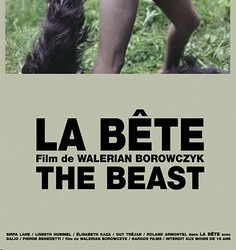
It comes as no surprise that pornos often “adapt” movies or parody Hollywood as their source material. But, there is such a thing as “avant-garde” pornography, where the goal is less stimulation for its own sake than an attempt at exploring and rationalizing that stimulation, taming it into something that is less animal and more intellectual.
Both realms, those of the artist and the pornographer, borrow heavily from characteristic literary figures who have, for better or worse, defined and defied the limitations of erotic expression.
The Handmaiden, while chock-full of “steaming hot lesbian tribbing action,” runs closer to the avant-garde side of things. It is in fact more interested in the relationship between performativity and the realization of desire. Thus, Park explores the counterintuitive fashion in which we go about our lives presenting an illusion of ourselves to the rest of the world in order to get what we want.
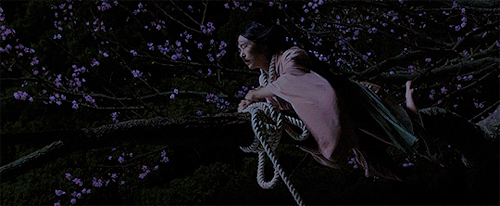
This translucent supra-ego, this self-applied sheen of imago, is never entirely public and never entirely private, remaining complicit in a web of deceit so dense as to be largely invisible. You might even say that the film represents this illusory self in the form of its genre, as a conventional mystery-thriller, while subversively defying the expectations of that genre through its aesthetic considerations of a sexuality freed from gendered construction.
Like a lover, we are always aware when The Handmaiden is lying to us. Each character’s behavior and dialogue is carefully constructed to mislead the audience towards unfounded conclusions regarding their motivations. Upon the conclusion of each of its three chapters, the degree to which each character is wrapped up in their own metafictional narratives becomes more and more apparent.
Only when the two female characters are allowed to act on their own sexuality, rather than suppress it or display it strictly for the interest of other parties, are they able to free themselves from their falsely constructed personalities and realize the actuality of their desire to be together.
39 notes
·
View notes
Text
Hearts Of Gold – A Very Brief Look at the Character Design of Jojo’s Bizarre Adventure
If I were to describe Jojo’s Bizarre Adventure in a single word, I think it would have to be “audacious.”

I would be very surprised if there’s anyone out there that doesn’t have even an inkling of an idea of what Jojo is about, but to put it as briefly as possible: Jojo’s Bizarre Adventure is a long-running manga (that has since given birth to a multi-media franchise, including animation, video games, and an exhibit in the Louvre) that tells the story of the Joestar family, spanning years, generations, and various casts of characters. The foes that the Joestars face range from vampires to superhuman immortals to everyday human beings empowered by the ghostly avatars of their resolve and desire. The Joestars and their allies use their own ghostly avatars (most commonly known as Stands), along with other forces such as the manipulation of energy via proper breathing or the weaponization of the Golden Ratio. Oh, and later in the story alternate universes come into play.
I’ve joked in the past that the secret to Jojo’s success is that the mangaka, Araki Hirohiko, simply does whatever he wants. Emotions are rarely anything less than bombastic, characters pose like abstract art pieces, Stand abilities range a seemingly endless range of possibilities, and are named after popular Western musicians and songs, and can be found in infants, turtles, hawks, haunted cat-plant hybrids, intelligent colonies of plankton, and trees. Basically, Araki never seems to ask himself “is this TOO ridiculous?” Honestly, in my opinion, at times it can be— but most of Jojo’s appeal is in how fantastic and delightfully bonkers it can get. If there’s anything Araki does differently, it’s that he is unafraid to let loose, which has made Jojo’s Bizarre Adventure the pop culture sensation it is today.
And if there’s anything Araki is good at letting loose about, it’s character design. Araki (who has gone on the record confirming the importance of the fashion world as an influence for his work) has a knack for designing outfits that are absurd and iconic and outlandish and stunning all at the same time— and in the world of Jojo, a character’s wardrobe is always a key part of their design. Iconic hairstyles, accessories, and tattoos are plentiful. And I could write an entire essay about the otherworldly and delightfully bizarre Stands alone.
I’ve come to find I have a deep love for character design and the thought that artists put into them— so much so that I’m actually in the middle of writing another essay about the character design for another series, Yowamushi Pedal. But as a sort of “appetizer” for that essay (and a “warm-up” to get me back into proper writing form for this blog), I’ve decided to write a small essay on what’s probably my favorite example of character design from this series while also examining what makes it so good.

Higashikata Josuke is the protagonist of Diamond is Unbreakable, the fourth major part of Jojo’s Bizarre Adventure, and (at the time of writing) the part that has most recently been adapted into an animated series. Unlike previous Jojo installments, DIU has a specific and consistent setting: Morioh, an average and unassuming Japanese town whose only real oddity is the disturbingly high amount of missing person cases. This, of course, ends up being linked to the power of Stands, and Josuke and his companions take it upon themselves to solve the mysteries of their beloved hometown and bring the unknown killer to justice.
Despite a few vices typical of your average teenage boy and a shockingly explosive (and specific) temper, Josuke’s defining character trait is his kind and noble heart. His major goal of the series is to keep his hometown safe from malevolent Stand users, but he actually ends up befriending many of the enemies he and his companions defeat.
What does all of this have to do with character design? Simple: Josuke’s design effectively communicates almost all of this information.
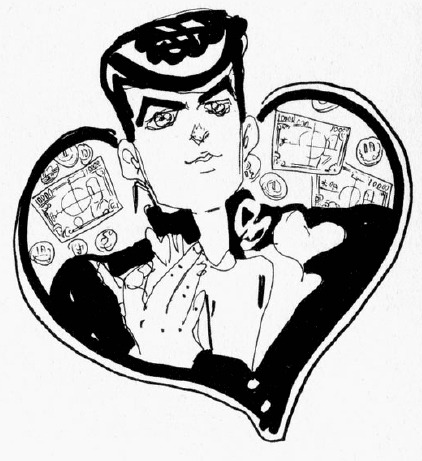
We’ve already established Araki has an eye for fashion, and even working with a typical high school uniform he’s able to create a look that’s all at once stylish, grounded (at least, for Jojo) and instantly recognizable. But the main thing I want to talk about here is the repetition in Josuke’s design. Repetition is one of the principles of visual design, and the idea is simple: repeating a visual element in your design will create a sense of unity and cohesiveness. This is mostly applied to things like graphic design, but I find repetition is a great way to create excellent character design as well.
Have you guessed what the repeated element in Josuke’s design is? That’s right: he wears his heart on his sleeve.
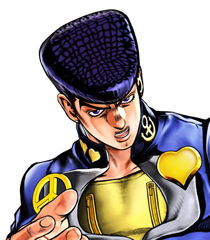
Or, rather his collar. Josuke customizes his school uniform with pins, and three of those five pins are heart. Most notable is the larger one he wears on his open jacket flap, opposite a large peace sign. One could definitely say that “love and peace” is Josuke’s ultimate goal in bringing the killer of Morioh to justice.
Speaking of the flaps of his jacket, take a close look. While it’s not as obvious as the stylized pins, the shape of Josuke’s open jacket creates what’s unmistakably a heart shape. Even Josuke’s silhouette calls to mind a heart: compare the width of his shoulders and chest to his waist.
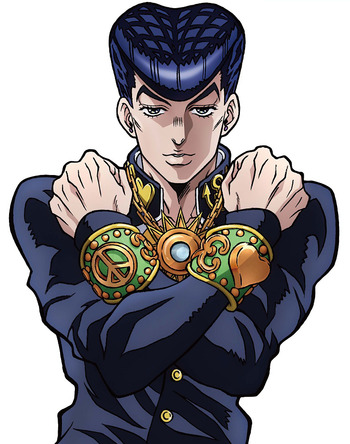
Of course, we can’t talk about Josuke without talking about his hair. Josuke’s hairstyle is great, not just because it’s snazzy (it is) but also because it’s a rare QUADRUPLE-hitter of character design. First, obviously, is the fact that it continues the heart motif (only at certain angles— it’s even more pronounced in the anime). More important than that though is the fact that it’s instantly distinctive and even iconic, setting him apart not only from his fellow “Jojos” but from other characters in Japanese pop culture as well. Even if you only saw him in silhouette, you could probably identify Josuke by the shape of his hair alone.
Perhaps most cleverly of all, though, is how it sets up a contrast that serves to communicate Josuke’s character depth. See, in Japan, particularly in Japanese media and pop culture, pompadours are typically shorthand for a delinquent. When the audience first meets Josuke, more likely than not they’d assume he’s a bit of a rough kid (especially since the previous “Jojo” was a delinquent himself), leading them to be surprised when his introduction scene sees him attempting to be friendly with a local turtle to get over his fear of reptiles.
It’s a classic set up and reversal: “the delinquent with a heart of gold.” Nowadays it’s starting to become a bit of a cliché, but at least it’s a starting point for character depth. But Araki gives this trope another twist: in Josuke’s introduction (and establishing character moment), Josuke encounters some of his upperclassmen. They talk down to him, harass him, and even hurt the poor turtle, but Josuke, being a freshman, is of course too polite to talk back to his senpai.
And then one insults his hairstyle.
Instantly Josuke’s entire demeanor changes. One broken nose later, the upperclassmen are running for their lives, the turtle’s shell is mysteriously fixed, and the audience is beginning to get it. Josuke is a nice guy, he has a set of morals he sticks to, but he’s not a pushover, and he’s definitely not opposed to violence. In short, he’s far more than just a high school punk.
As for why Josuke’s hairstyle is such a big deal to him, that’s the last important detail about it: it ties into Josuke’s history, and therefore, his motives. As it turns out, Josuke’s hairstyle is modeled after that of a mysterious stranger that helped him and his mother many years ago. Inspired by the man who saved his life, Josuke decided to live his life as he believed his savior would, which reflects in his compassionate nature at the time of DIU— wouldn’t you know it, linking neatly back to the heart shape, specifically as a symbol of love.

It’s things like this that make me wonder is Araki is a genius, or simply ridiculous.
Anyways, the short and long of it is that’s Josuke’s pompadour continues the heart theme. That theme also just so happens to continue in his Stand, Crazy Diamond. There’s hearts all over Crazy Diamond’s design, some blatant, some more subtle (hint: look at its shoulders). And of course, its helmet-like head is an obvious parallel to Josuke’s hair while also incorporating a heart-like shape. As an extension of Josuke, it’d only make sense for Crazy Diamond to also possess his motif.

But what does the motif mean? Well, I probably don’t have to tell you. Even if you somehow didn’t know that hearts are visual shorthand for love and affection, the round edges might clue you onto the fact that it’s a “soft” shape, similar to how a circle carries connotations of approachability. Hearts are love, kindness, compassion— all that warm and fuzzy stuff. Basically, Josuke’s “hearts” are all meant to clue the audience to the fact that he’s a good kid.

This is reflected in the main ability of Crazy Diamond. On paper, Crazy Diamond’s ability is “restoration,” allowing Josuke to return anything to a previous state. The most common application he uses this ability for, however, is healing the wounds of others. As Jotaro says early in the story, while humans are naturally drawn to violence and destruction, Josuke’s strength is rooted in his compassion. It’s his compassion that leads to him befriending his many allies over the course of DIU, even those who started as his enemies. And ultimately, it is the culmination of all these different bonds that lead to the defeat of Morioh’s killer.
Diamond is Unbreakable is often referred to by fans as something of a “slice-of-life” series. While there’s plenty of action and drama, this classification isn’t entirely inaccurate, what with the small town setting and the fact that most of the cast are high-schoolers and otherwise average people, despite all the punch ghosts. Even with all the fights and mysteries, DIU is more of a story of characters, of their strengths, weaknesses, inner conflicts and interactions. It’s a “softer” chapter in the story of Jojo’s Bizarre Adventure, and Josuke, with all his “softness,” is the perfect protagonist for it.
In talking about Josuke’s character design, I actually ended up talking a lot about a lot of other things, including Josuke as a character and the themes of Diamond is Unbreakable— and that’s precisely why Josuke’s character design is so fantastic. You see, aesthetics are great, but a character’s design should ultimately tell me about the character, and if it also happens to communicate some central themes of the story, well, the more the merrier. Josuke’s character design is one of my favorite Jojo designs, and stands as a testament to the power of a few repeated elements as well as what a good character design can communicate.
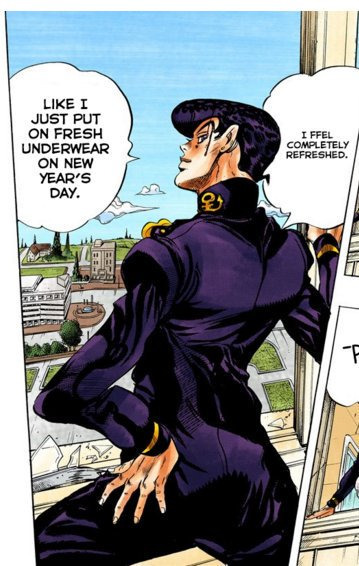
Araki Hirohiko, your manga is ridiculous, but it’s a damn good kind of ridiculous. Shine on, you crazy diamond.
Diamond Is Unbreakable can be watched with subtitles on Crunchyroll, along with all the previous seasons of David Production’s current adaption of Jojo’s Bizarre Adventure.
#jojo's bizarre adventure#jjba#diamond is unbreakable#josuke higashikata#wwydd?#manga#anime#character design
391 notes
·
View notes